You want to build your email list.
So you spend 20 hours pitching, outlining, and writing the perfect guest post.
You spend another 3 hours researching and creating the perfect content upgrade to go along with that guest post. You go back and forth with the editor for what seems like hours, making small tweaks and changes to the article, polishing it into pure genius.
The post goes live, and you happily rake in 100 new email subscribers. Rockin’, right?
Actually, nope.
For every hour you spent on that post, you added fewer than 4.5 email subscribers to your list.
If each email subscriber was worth $1/month on your list, you’re looking at $100/month maximum impact of that guest post. And that’s a one time benefit.
You might get a couple more subscribers trickling in after your post goes live, but it’s heyday is really just a short window. If you wanted to add another 100 email subscribers to your list next month, you’d have to spend another 20-something hours guest posting… again.
So what if I told you that with just a few hours of work upfront you could create a list-building machine that paid dividends every single month…without any extra effort or time?
And that you don’t even have to leave your own site to do it?
How?
Through conversion rate optimization to convert more of the traffic you’re already bringing to your site.
Think about it. That 23 hours you spent on your guest post netted you 100 email subscribers the week it was published. But if you increase your conversion rate from a sad 1% of visitors to even just 5% of visitors, even if you only get 100 visitors to your site per day…
You’d collect an extra 120 email subscribers every single month. Without any extra work.
All you have to do is know these 34 conversion rate optimization strategies that will help you convert more of your existing traffic, relieving you of the pressure of always having to go out and pound the pavement to grow your list.
- Strategy #1: Create an Opt-In Offer
- Strategy #2: Work On That Headline
- Strategy #3: Use the Mind-Blowing Potential of Power Words
- Strategy #4: Use the Words Your Audience Uses
- Strategy #5: Use the Word “Free”
- Strategy #6: Use the Word “Get”
- Strategy #7: Stop Being So Selfish
- Strategy #8: Stop Listing Features
- Strategy #9: Make Sure Your Opt-In Can Stand on It’s Own
- Strategy #10: Paint a Picture
- Strategy #11: Use Numbers and Results
- Strategy #12: Set an Action Color
- Strategy #13: Pay Attention To Your Button Copy
- Strategy #14: Remove Distractions
- Strategy #15: Give Them More Opportunity to Opt-In
- Strategy #16: Decrease Your Page Load Time
- Strategy #17: Make Sure Your Website is Responsive
- Strategy #18: Make Your CTA Jump off the Page
- Strategy #19: Pre-Empt Objections
- Strategy #20: Use Social Proof
- Strategy #21: Use Testimonials and Quotes
- Strategy #22: Use Exclusivity
- Strategy #23: Get Your Foot in the Door
- Strategy #24: Trigger Fear with Scarcity
- Strategy #25: Build in Urgency
- Strategy #26: Use Human Faces
- Strategy #27: Use Lines of Sight
- Strategy #28: Use Motion
- Strategy #29: Show ‘Em What You Got
- Strategy #30: Make Them Make a Choice
- Strategy #31: Show How Far They’ve Gotten
- Strategy #32: Consider Ditching the Opt-In Disclaimer
- Strategy #33: Stop Asking for Too Much Information
- Strategy #34: A/B Testing
But 34 strategies is a lot. So we've put together a FREE spreadsheet with every single strategy for increasing your conversions.
Click here to get the spreadsheet (FREE) and increase your conversions
Now that you've got the spreadsheet, let’s get into the strategies.
Strategy #1: Create an Opt-In Offer
How much traffic does your site get every month?
If you said 100,000 visitors or more, you can skip this section. But most of you aren’t in that boat, so lean in and pay close attention:
You need an opt-in offer.
Call it what you want: lead magnet, bribe to subscribe, freebie, upgrade, but as we recently told you, unless you’re a huge blog you can’t just ask for email addresses.
Think about the numbers. There are over a billion websites on the interwebz. That number is constantly increasing. And most of them suck. But the ones that don’t suck and actually generate traffic?
They do email marketing.
So that means that a ton of super useful, highly competitive websites in your niche are vying for your visitors’ email addresses. Why would those visitors give it up to you with no benefit to themselves?
So you’ve gotta give something away for free.
You can do this through a content upgrade, like we do on almost all of our guides:
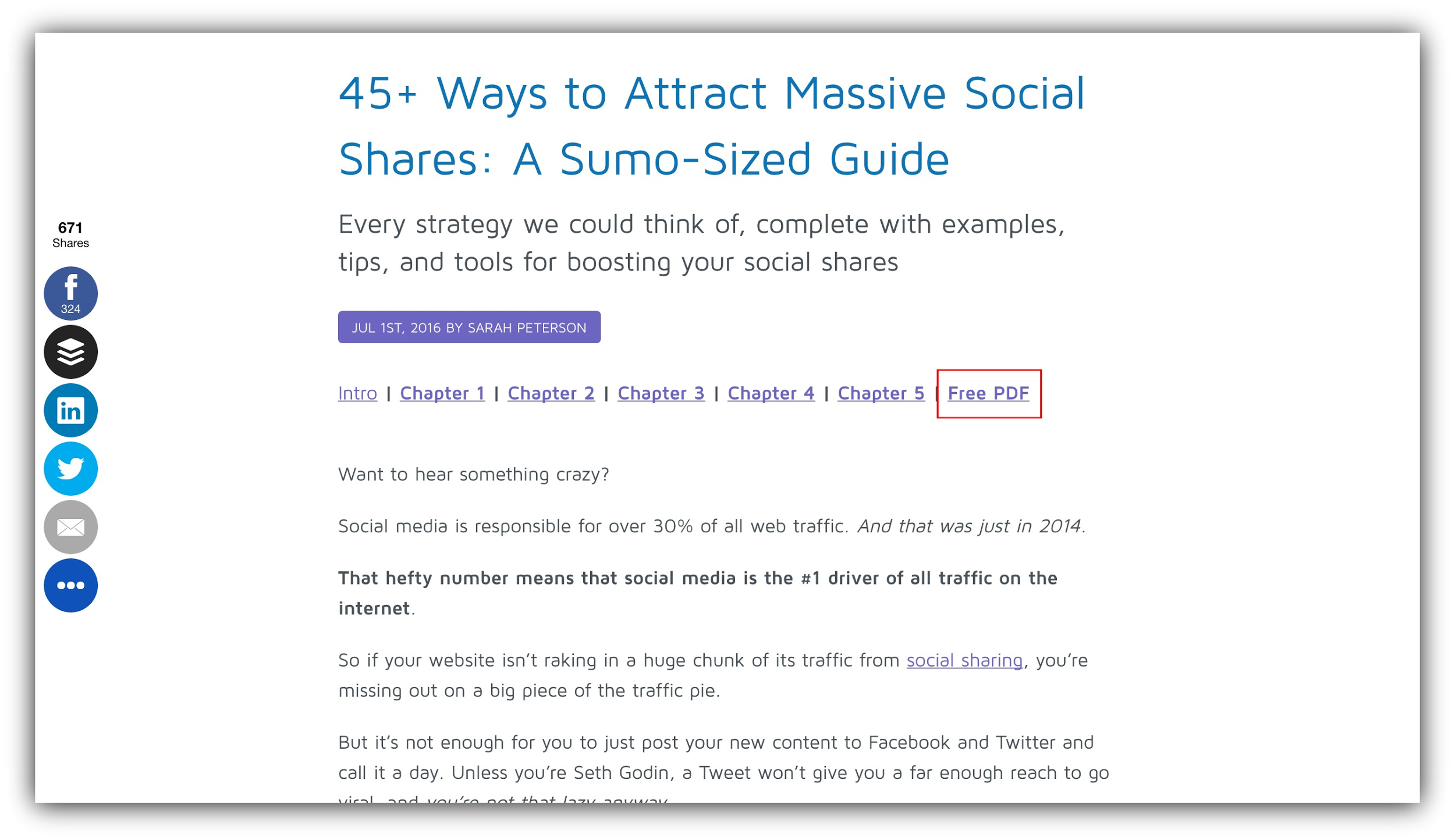
Or a general site-wide opt-in offer so you don’t have to create new opt-ins constantly, like on The Busy Budgeter:
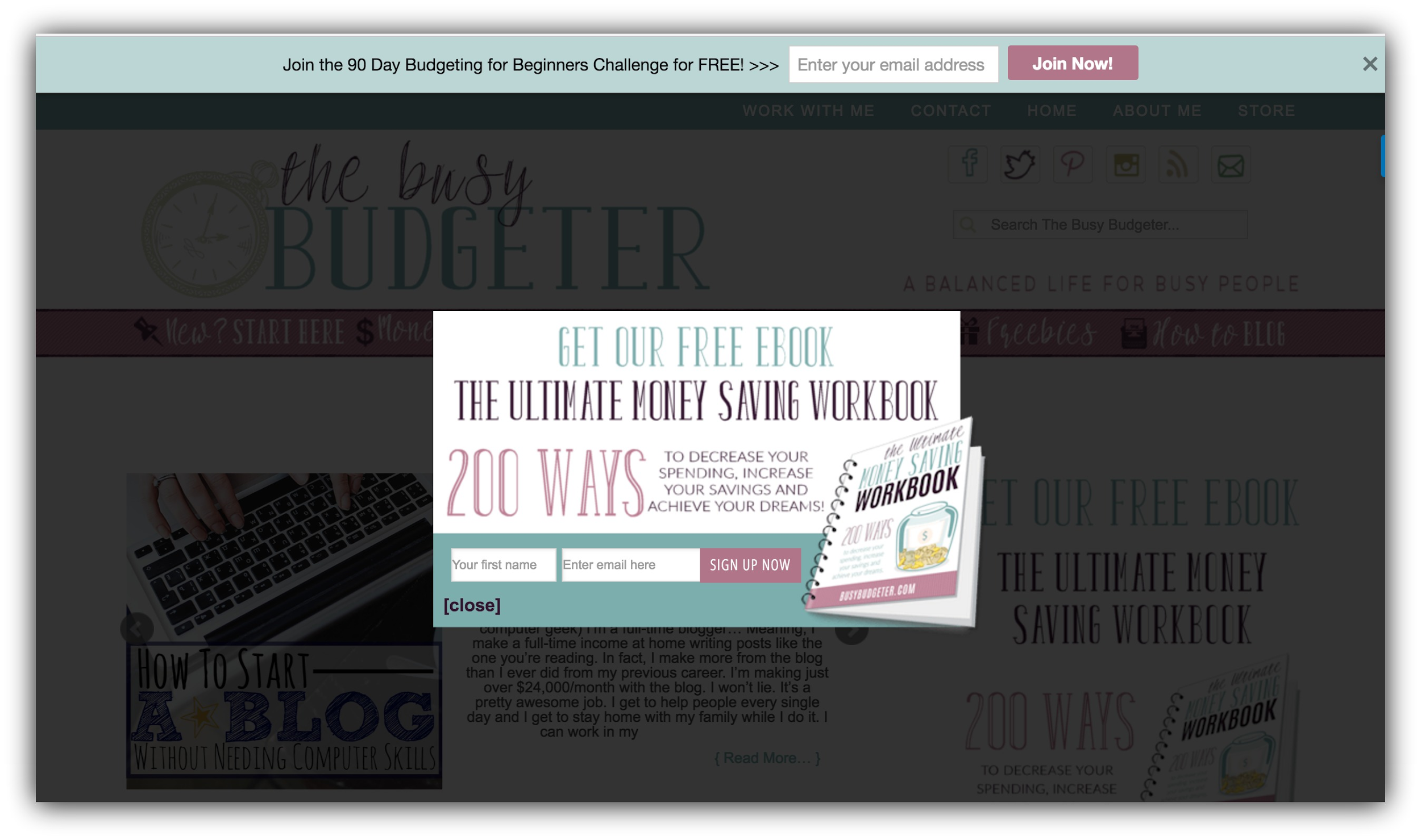
But don’t just expect your visitors to cough up their email addresses for nothing in return. Create a highly valuable opt-in offer that you know your audience will love, and offer it on your site in exchange for the email address.
And then, use the rest of this guide for selling that offer.
Strategy #2: Work On That Headline
Sometimes, email marketing and content marketing blend their DNA to make the perfect little marketing babies.
And this point is the perfect demonstration of how the most important element of content marketing (headlines) contributes a crucial element of email marketing.
Without a strong headline, nobody will subscribe to your email list.
This is unsurprising. About as unsurprising as the fact that email subject lines are also headlines, and if your subject line sucks so will your open rates, clicks, and sales.
Your headline is the first point of contact your target audience has with your opt-in offer or newsletter. They don’t get to see the excellent resource you created for them or the content of your emails until they subscribe. So all you have is your headline to get the email.
Create a strong, compelling headline that describes exactly what your newsletter or opt-in offer helps subscribers achieve.
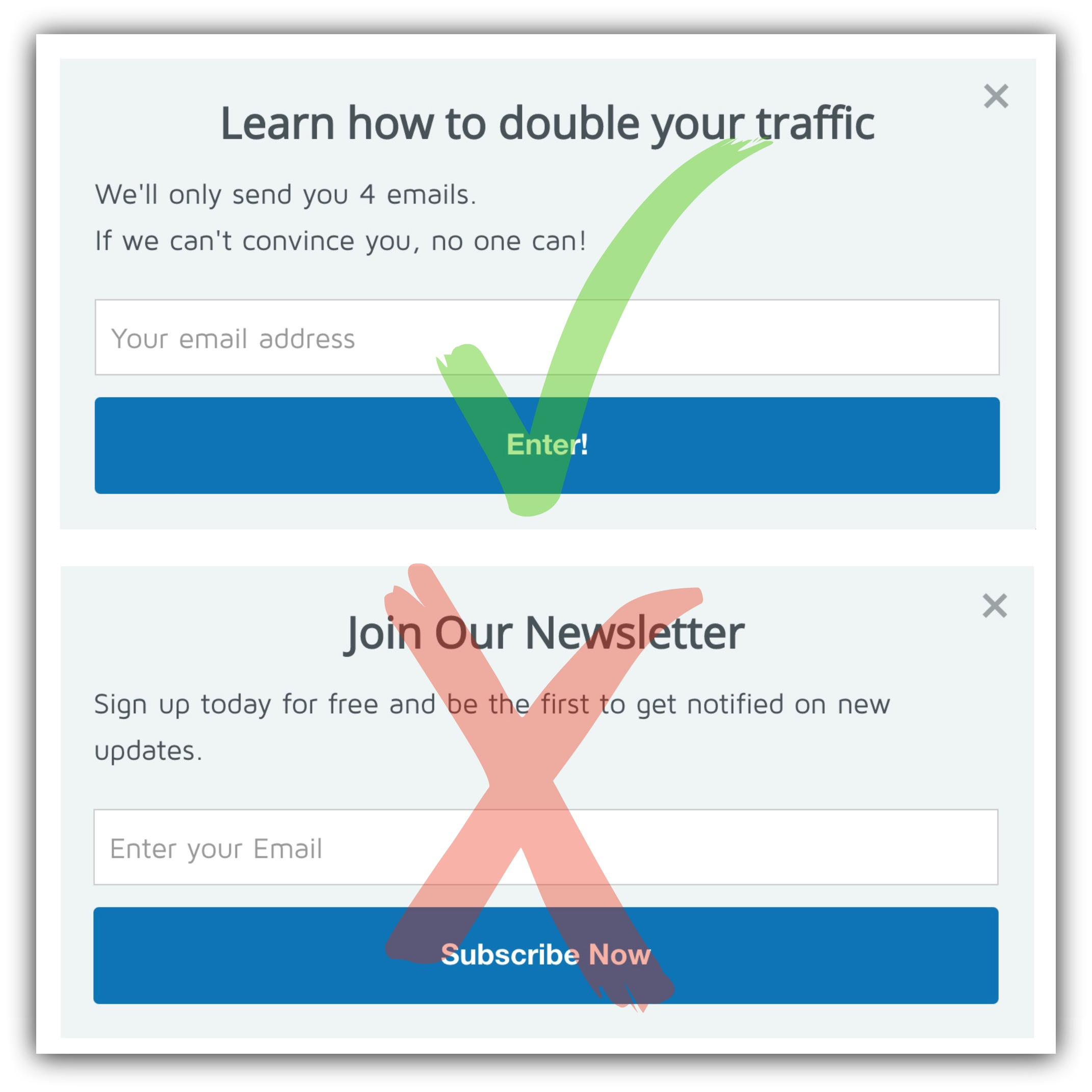
This will be the one conversion rate optimization strategy that will propel your email list forward at turbo speed – not to mention add plenty of percentage points to your conversion rates.
Don’t know where to start with headlines? Here are 49 headline formulas to skyrocket your conversions (plus where to use them).
Strategy #3: Use the Mind-Blowing Potential of Power Words
Power words.
You’ve seen them in headlines:
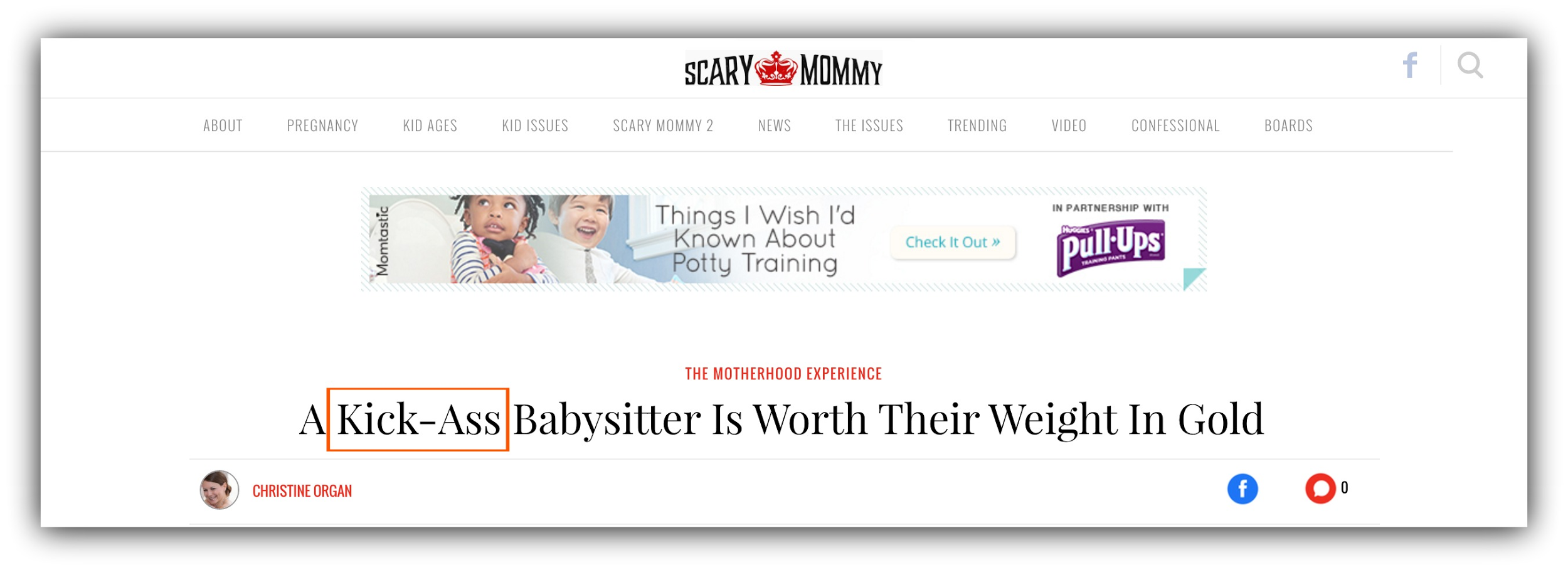
In product names:

And even business names:

And they’re widely used because they work.
Power words are words that add a little "oomph" to your text by eliciting emotion. They draw out excitement, fear, or anxiety in your target audience to make those headlines and subject lines much more clickable.
And when they aren’t abused (such as with clickbait titles), they’re descriptive, specific and entice people to consume content that will benefit them.
So it goes to show that you absolutely should be using power words in your opt-ins to increase your conversions, too.
Use power words in your button copy, your headline, and your description. Check out how Convertt.org does this:
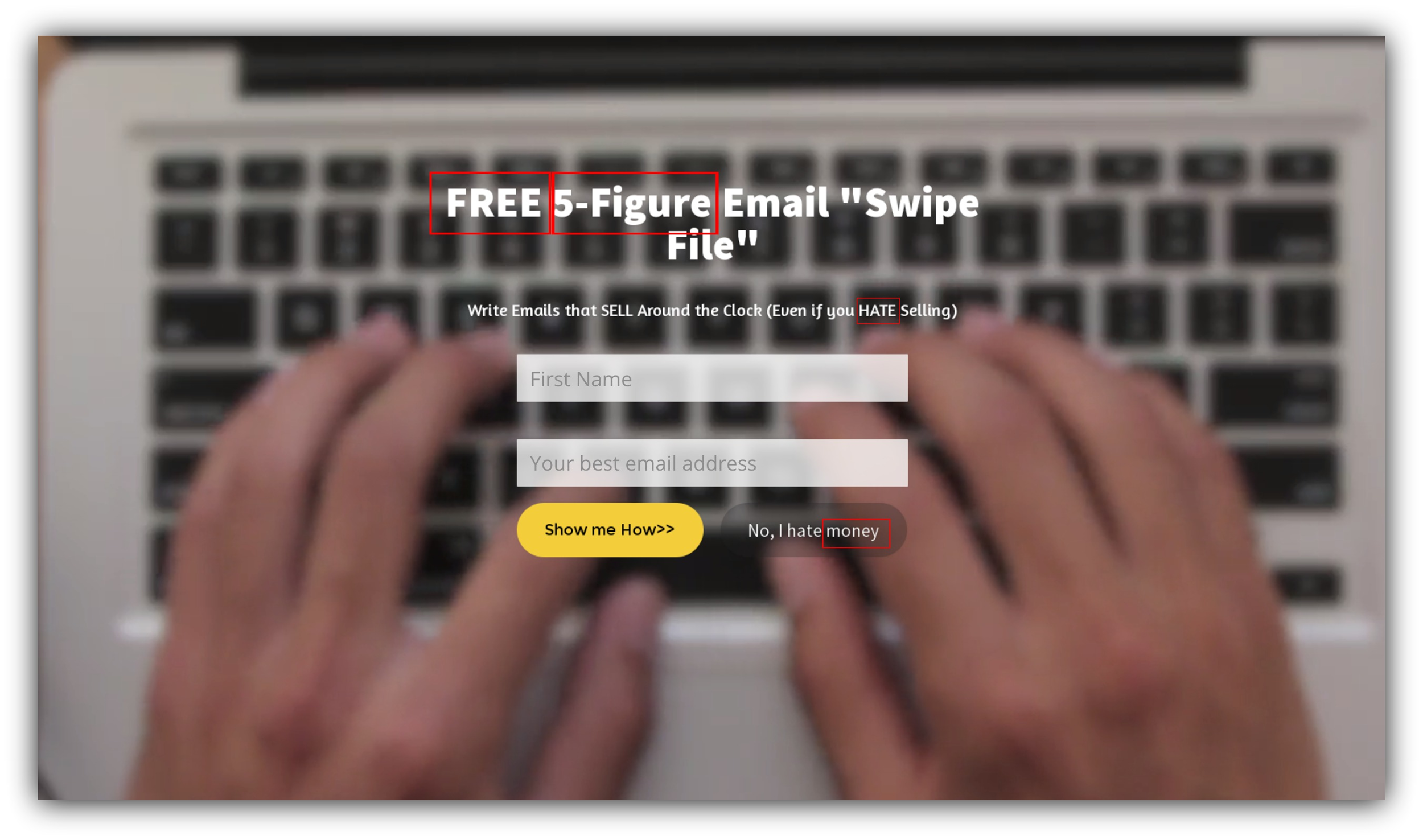
Don’t throw any old power word in there, but don’t shy away from using descriptive power words that establish authority, present what you offer, and make your offer more enticing.
Don’t know what power words to use? Turbo-charge your marketing with these 355+ power words.
Strategy #4: Use the Words Your Audience Uses
Lean in, because I’m about to drop a copywriting bomb on you…
The best thing you can do for your copy is to read your audience’s mind.
When you can read your audience’s mind, you can show them that you know what they’re struggling with. You can resonate with them.
There’s no better way to connect with your audience than to echo the thoughts they’re already thinking, and show them you can help them.
And the best way to do so is to use the language that they use to describe the problems they’re having – or the solution you’re offering – in your opt-ins.
After all, as Jay Abraham said…
If you can define the problem better than your target customer, they will automatically assume you have the solution.
But that sounds pretty impossible, doesn’t it?
Luckily, it’s not. In fact, your audience makes it quite easy to read their minds by having conversations on social media and community sites.
Do a little eavesdropping on Reddit, in Facebook groups, and on forums to find out how they talk about their problems.
Then, echo that language back to them when you’re creating the copy for your opt-ins.
Let’s give you an example. Let’s say you create content for beginner photographers, and your offer was a list of alternatives to Lightroom with discount codes.
To do some social listening, you were in the Photography for Beginners Facebook group, and you stumbled across this post:

If I were in your situation, I might make my headline for the opt-in something like:
Lightroom Crashing Constantly? 6 High-Performing Alternatives (With Discount Codes)
See how I used the poster’s language, "crashing constantly" to echo their thoughts? He’s probably not alone in thinking like this, and it humanizes the language in a way that can resonate.
Do some social listening and use the language your audience uses. Don’t know where to start? Here’s how to get to know your target audience better than they know themselves.
Strategy #5: Use the Word "Free"
The word "free" is as downright intoxicating to humans.
In Dan Ariely’s book Predictably Irrational, researchers set up an experiment with the holy grail: chocolate.
They offered passersby 2 types of chocolate:
- A Lindt truffle for $0.26
- A Hershey’s Kiss for $0.01
-
In this experiment, 40% of people bought the truffle, and 40% bought the Kiss. But then the researchers lowered the prices of both chocolates by a penny:
- The truffle was now $0.25
- The Kiss was now free.
-
This pushed the needle: 90% of buyers opted for the free Kiss even though the relative price was the same.
There have been other experiments that also demonstrate the pathetic extent to which we’re suckers for "free" – like the one where Ariely did an impromptu survey of people waiting in line for a free tattoo, and found that 68% of the people getting a tattoo wouldn’t have even gotten the tattoo if it weren’t free.
Mind blowing, right?
So if you’re giving away something for free – which I’ve already advised you to do in the very first point – you should advertise it as such. Don’t be afraid to whip out your "free" tool.
Check out how GoSpotCheck offers a free trial on their Welcome Mat to increase conversions:

Now they were too smart to try this, but imagine if they decided to just demand that you try their service without offering it up for free:
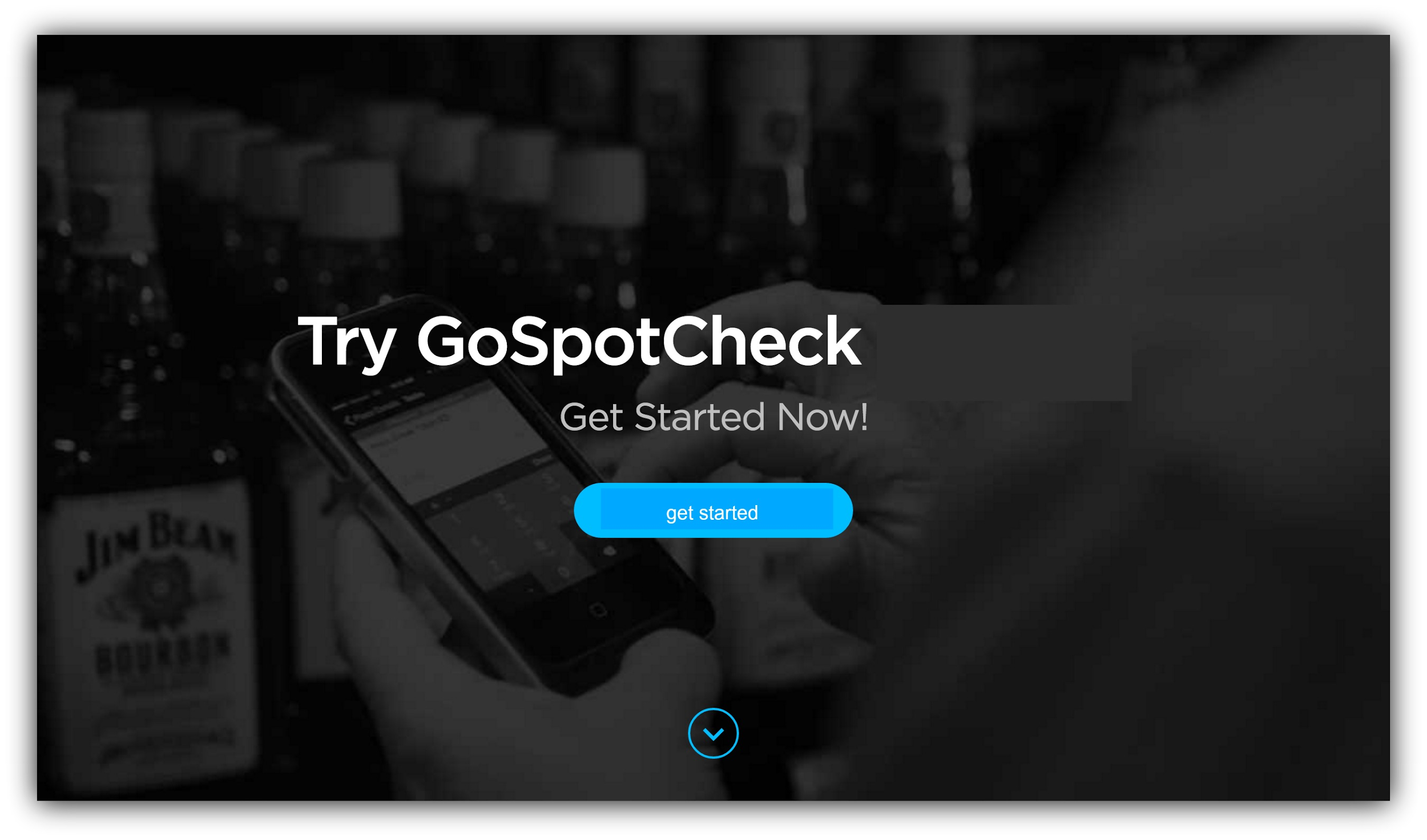
Not as effective, right?
Throw the word "free" into your opt-in copy to boost your conversion rate significantly.
Strategy #6: Use the Word "Get"
Can you spot the difference between these two sentences?:
"I have to build my email list."
“I get to build my email list.”
Yup, I just swapped out the word "have" for the word “get”. Nothing fancy, right?
Yet they imply two entirely different concepts. The first sentence implies obligation, or that building your email list is a drag. The second sentence implies pleasure, or that building your email list is something you have the privilege to do.
Now think of the word "get" in an offer:
"Get the email course" vs “Subscribe for the email course”.
In this case, the word "get" implies something that is free, and something that you get without much effort or struggle. You’re not giving anything up to get the email course.
On the other hand, "subscribe" brings to mind parting with something (in this case, your email address). It also implies that you have to do some work for it, even if it’s just the act of subscribing.
The language you use in your opt-in opportunities can also change the tone – and therefore your conversion rate.
Work in the word "get" in your opt-in forms and A/B test it with other words that don’t have the easy undertones “get” does. You may be surprised.
Strategy #7: Stop Being So Selfish
One of the things that irks me the most when I’m reviewing a website is something you might be doing without even realizing it…
Using self-centered language.
"Sign up for my email list" or “Get our free PDF” might seem like a great opportunity to you – after all, you are the one who benefits. But for the visitor or reader – the person you want to subscribe to your list?
They don’t want to sign up for your email list, subscribe to get your PDF, or get your free course.
They want something for themselves.
Take a look at this excellent Welcome Mat from Young Adult Money:
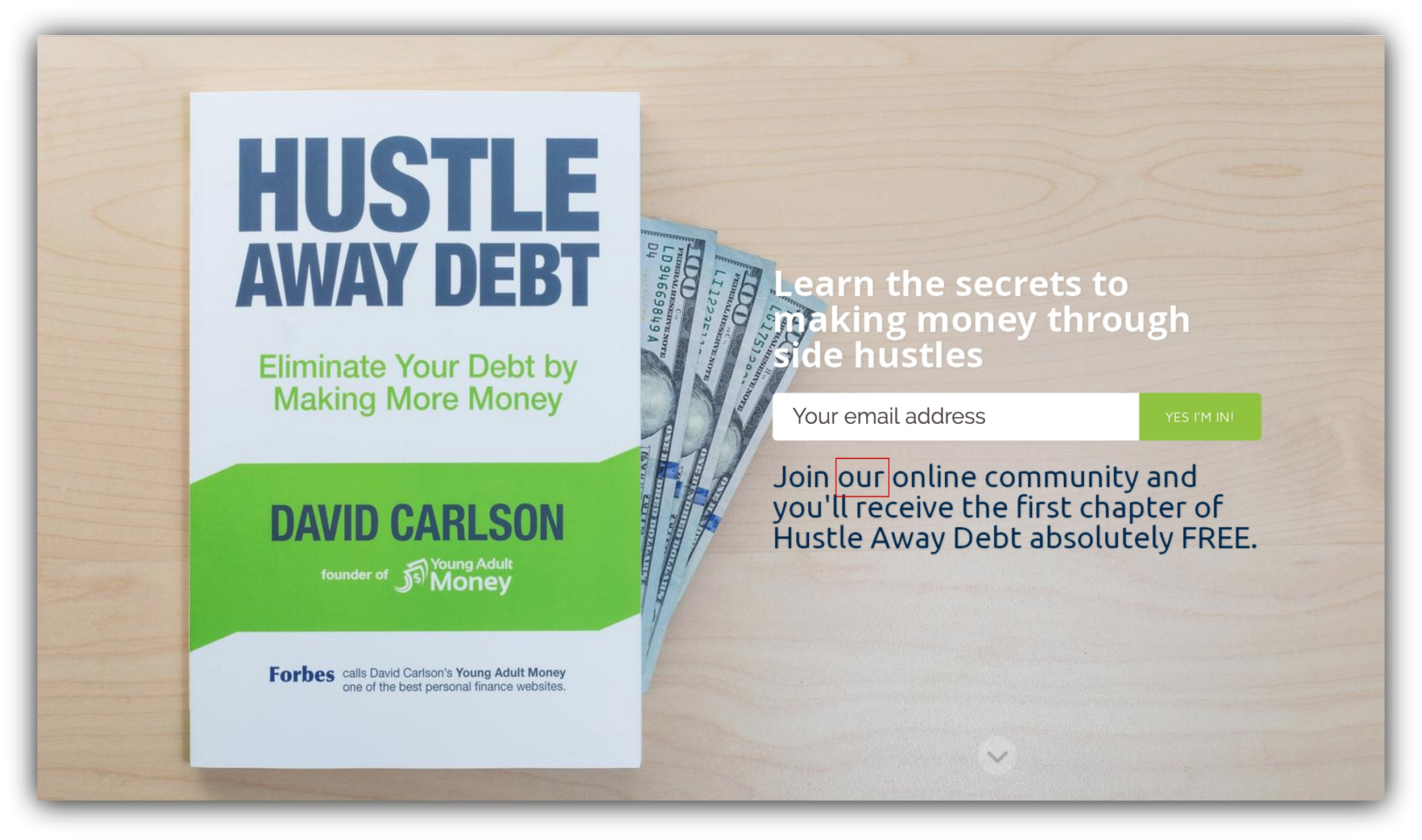
The site owner did everything right. He offered something for free, included social proof, used lines of sight, reduced the number of form fields, used the word "free" and even triggered the feeling of exclusivity.
The only thing that could be improved on this Welcome Mat is the possessive word "our".
It’s an easy mistake to make, so luckily it’s also an easy mistake to fix: swap out any possessive language you use on your opt-ins to reader-centered language for a stronger conversion rate.
Strategy #8: Stop Listing Features
Copywriters will sigh a collective breath of relief with this point, which is to watch your description.
A common mistake with descriptions for anything – products, opt-in offers – is listing features rather than benefits.
Let’s say you were describing your opt-in offer of a free email course. Instead of listing features like:
- 7 emails delivered over 7 days
- Checklists and downloadable PDFs included
- 12 videos and 6 audio files.
-
List what the email course will help your audience achieve and what they’ll learn in your course.
On my personal site Unsettle, my offer is a video class that I created with a time management expert:
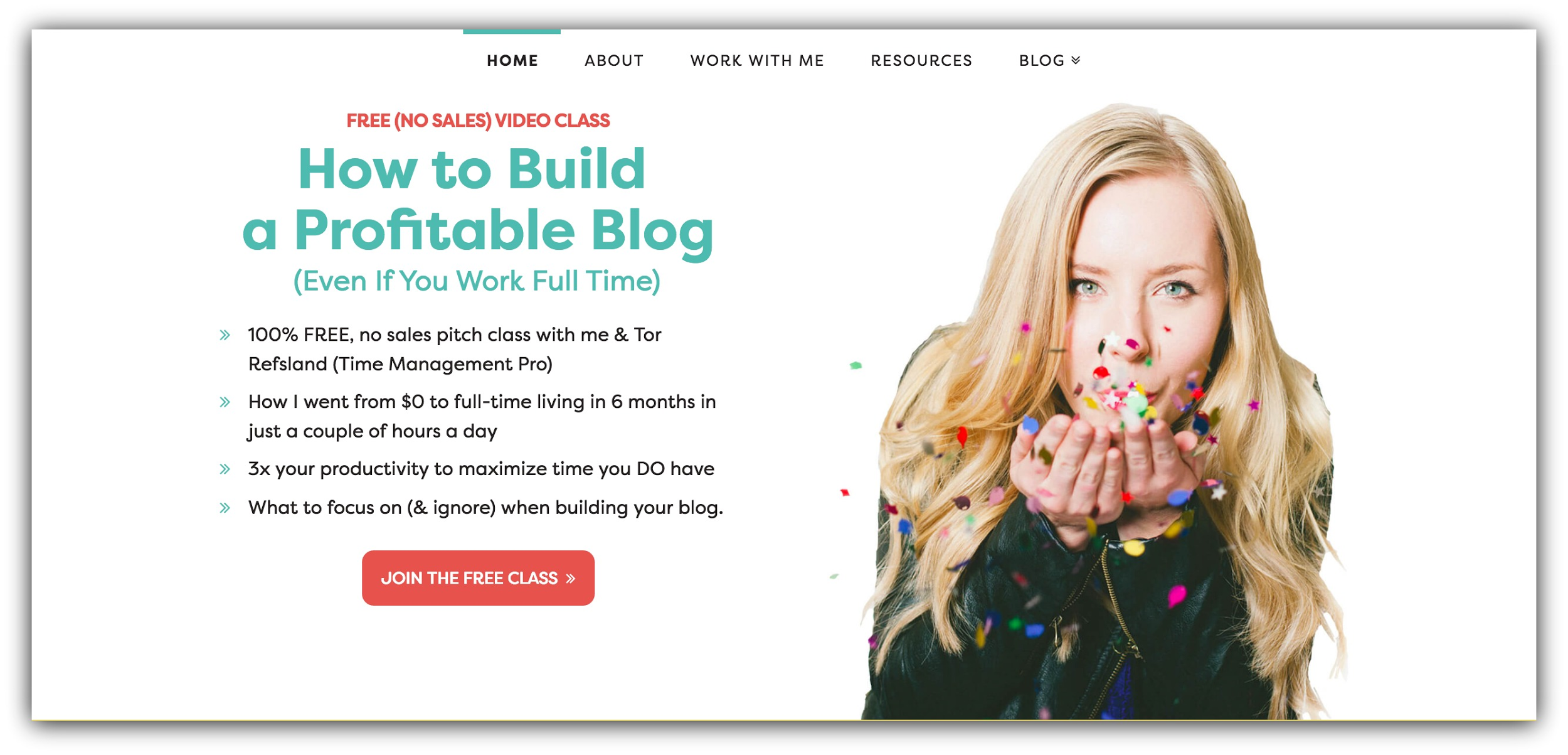
In my description, I list the benefits of the free class. Things like:
- 3x your productivity
- Learn what to focus on when building your blog when you work full time
- Learn how I build a profitable blog while working full time.
-
If you have a solid headline, the next portion of your opt-in your visitors will read will be your description.
Make sure it’s as benefits-driven as possible, and be specific.
Strategy #9: Make Sure Your Opt-In Can Stand on It’s Own
Let’s say you saw this opt-in form in the wild, without the context of a website:
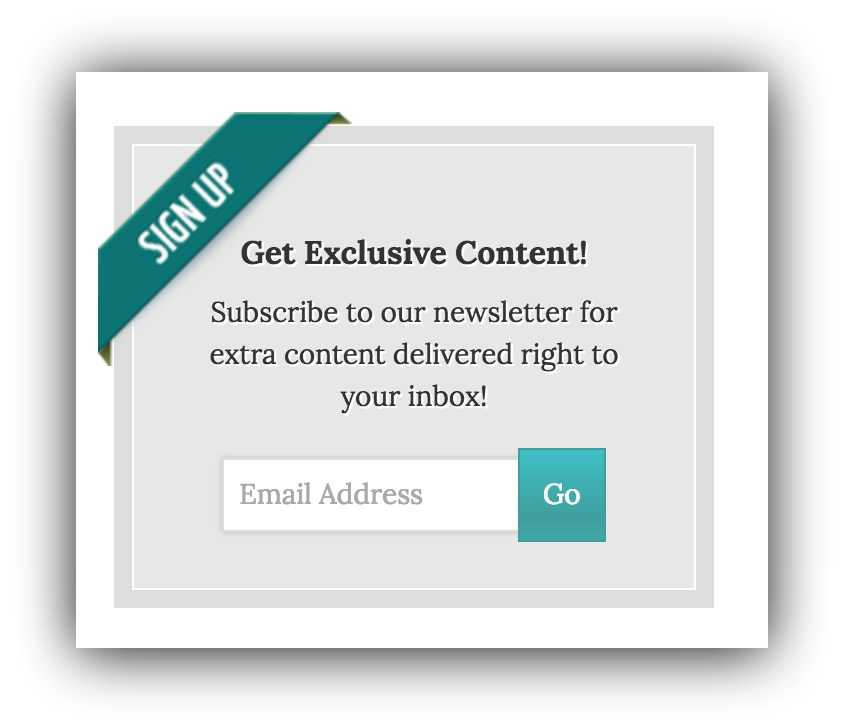
Would you sign up?
Probably not. After all, you have no idea what you’d be signing up for. What type of exclusive content? Whose newsletter? What are you even signing up for?
So even if you were part of this blog’s target audience and their content would be perfect for you, you’d never know.
What about this one?

I bet if you were part of this offer’s target market, you would sign up.
You know exactly what you’re getting: 3 free videos to help you increase conversions.
This List Builder pop-up immediately identifies their target audience (anybody who wants to increase conversions) and is descriptive.
My point here is that your opt-ins should be able to stand on their own. If I see your opt-in without the context of your website, I should be able to immediately figure out if it’s something I want.
You might be thinking that this conversion strategy is silly – after all, your visitors will have the context of your site to give them more meat.
But that’s not necessarily the case. If they click onto a link to your site through social media and you have a Welcome Mat or feature box, they haven't had the chance to gain any context.
And if you’re doing a good job with your opt-ins, even if you don’t present a Welcome Mat, feature box, or pop-up right away, the visitors eye will be drawn to whatever you're using to collect emails before they have a chance to gain context.
So make sure your opt-ins stand on their own. Avoid using vague descriptions and buzzwords like "exclusive content" (what is “exclusive content”? What will that “exclusive content” help me achieve?) and aim for specificity. I should be able to identify right away whether what you’re offering is for me.
Strategy #10: Paint a Picture
Imagine this…
You’re sitting on a blanket on a beautiful Parisian day. The spring sun warms your shoulders, and the grass tickles your bare feet. In front of you, the amazing Eiffel Tower looms over your head, seemingly as tall as the sky. You squint past the sun at it, admiring its size and architecture.
You sip your cafe au lait, as you hand the baguette and gruyère you’re sharing to your partner.
Tourists snap selfies to your left. French children giggle and play on the grass to your right…
Puts you right into Paris, right? And sort of makes you want to visit, to actually be savoring that gruyére and admiring the Eiffel Tower.
This is why having your audience actually imagine themselves using a product is one of the oldest and best sales techniques in the book — and anything that works for sales usually works for increasing email conversions, too.
Use your description to make your audience actually picture themselves receiving your emails, and getting the benefit of your offer.
It doesn’t have to be as long as my Parisian description — in fact, it shouldn't be — but simply asking your audience to picture themselves with the result you’ll help them achieve can be enough to convert.
Strategy #11: Use Numbers and Results
In a previous life, I was a recruiter.
And one thing we were always looking for on resumes and cover letters of applicants was proof.
It wasn’t enough to say that you saved your company time and money by implementing a new software to track customer information. We wanted to know how much money that system cost, and how much time and money your idea saved the company.
That’s because we recruiters are human. We like numbers, and we like proof. Numbers and results make the claim more tangible.
Using these figures on your job applications can increase your conversion rate from application to interview. And using those numbers in your opt-ins can increase your visitors’ conversion rate to email subscriber.
For example, I tested two Welcome Mats on my personal site for different opt-in offers.
One used a number in the headline (18 resources) and a result in the description (helped me get to my first $10K/month):
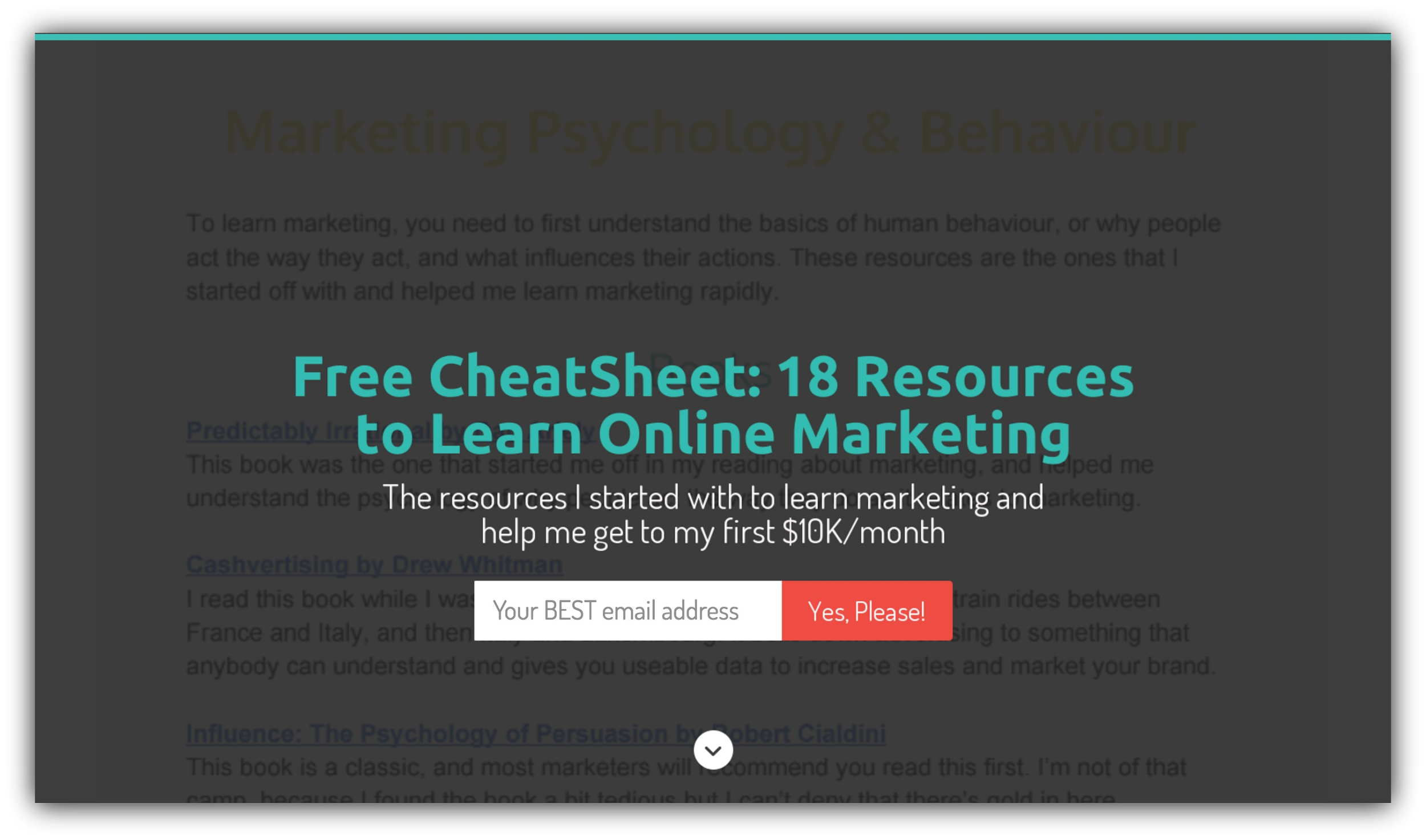
This Mat converts at just under 15%.
The other was descriptive and but didn’t use numbers or results – even though I could have used both for this opt-in (and have, with a similar conversion rate the the previously mentioned Mat).
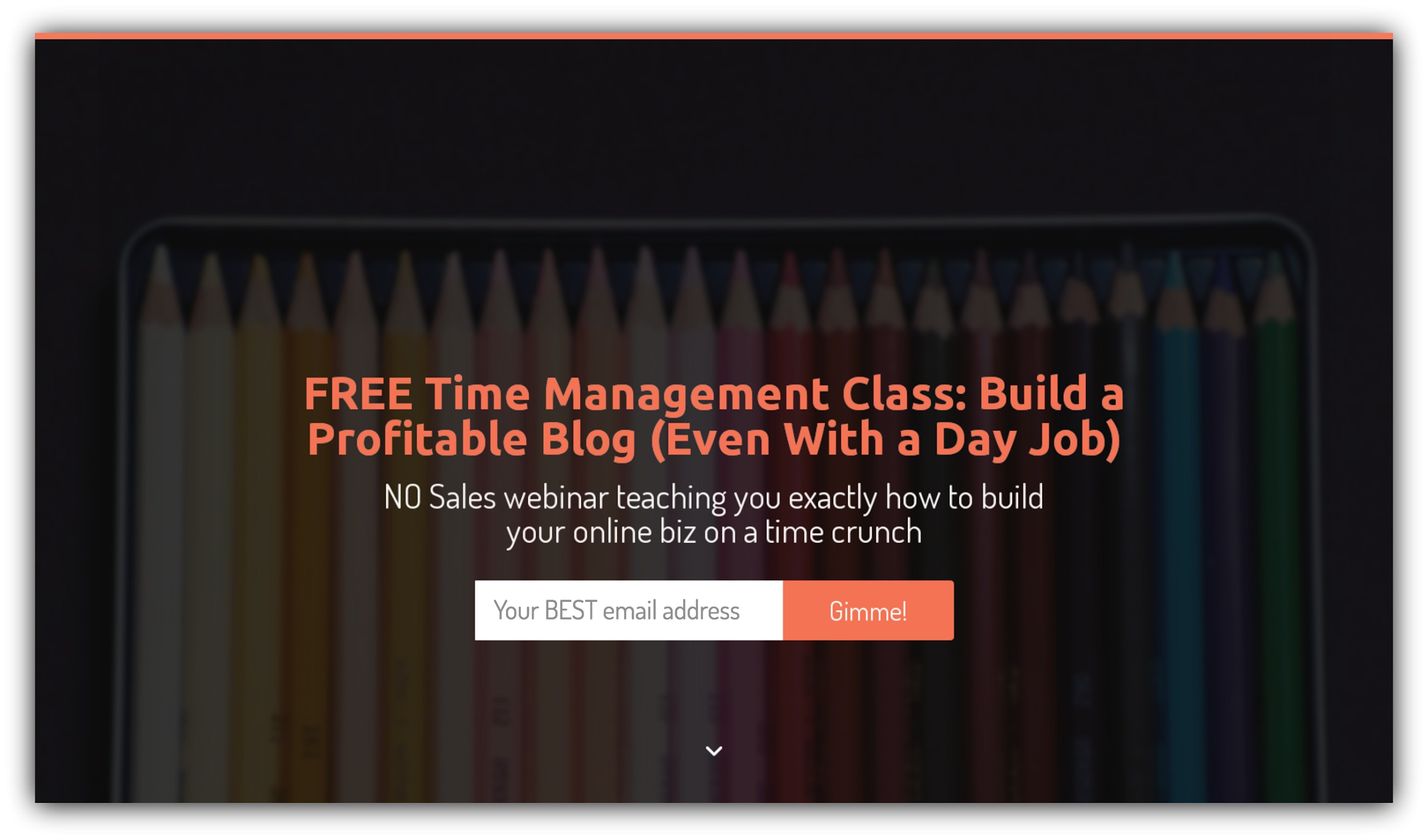
Without numbers or results, this Mat only converts at 3.21%.
That’s an increase of 5x, if you’re like me and math isn’t your specialty.
This is a form of social proof, but stands on it’s own because it’s so powerful. If you can show exact results and numbers, either that you’ve achieved with what you’re teaching or a reader or audience member has achieved, do it. Your conversion rate will thank you.
Strategy #12: Set an Action Color
If you’ve spent more than 10 minutes online reading about conversions, you’ve probably seen the great debate:
Red increases conversions!
No, green does!
Red’s a stop color!
No, it’s attention grabbing!
The truth is, what color your audience responds to depends on two things: your audience and your brand.
Whether red works for X company but tanked the conversion of Y company means nothing for you.
Even though red beat out green for Performable, to the tune of 21% no less, we did our own button color A/B test – and it was a test that red didn’t pass:

Our yellow button beat our red buttoned version (though only by 2.5%):

The lesson we learned with this is that the more eye-catching the color, the higher your conversions will generally be.
If we had used a gray or pastel colored button instead of bright red or yellow, that 2.5% difference would have had one less decimal point.
Use these eye-catching colors as action colors for your buttons and calls to action. Your color should jump off the page and stand out from any other color your website uses.
A/B test different bright colors to find out what your audience responds to.
Strategy #13: Pay Attention To Your Button Copy
So we just talked about button color, but even more thought has to go into your button to increase conversions.
Lots of power for a little box, right?
After you’ve nailed a button color that will jump off the page, next up is your button copy.
The words you put on your button matter. A lot.
In a split test done by Visual Website Optimizer, using a benefits-driven button copy ("Make money flipping websites") rather than a generic button copy (“Join us”) increased conversions by 33%:
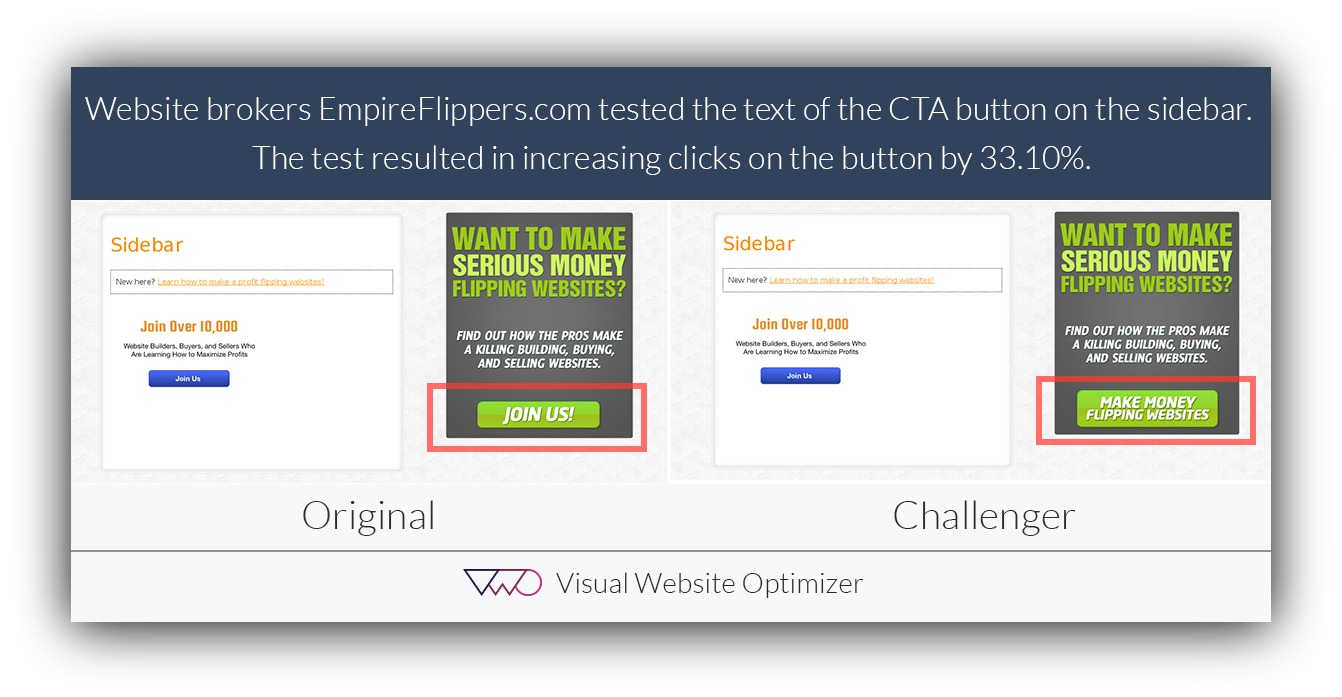
Remember what I said up there about being "self centered"? A lot of people make this mistake in their button copy, too.
They use generic calls to action like:
- Sign up
- Subscribe
- Join
- Submit
-
And while those may be easy, they don’t feel like the visitor is getting anything out of it.
Not only that, but they’re not tangible. Can you even define "submit"? What happens when you “submit” something?
Choose a benefits-driven button copy to increase your conversions – or at the very least, choose something other than submit.
Strategy #14: Remove Distractions
If you haven’t heard of the infamous jam study elsewhere, you’ve likely heard of it on Sumo by now.
The jam study is a popular marketing study that demonstrates the negative impact of too much choice on conversions. The study found that while giving many flavor choices in a jam display attracted more interest, the display with fewer flavor choices attracted more sales (ie conversions).
So how can this apply to increasing your opt-in conversions?
Because if you distract visitors with too many things to do when they land on your page, they’ll choose to do nothing at all.
So if, above the fold, you have links to a contact page, an about page, and opt-in offer, you blog, your podcast, your services page, and your product pages – along with links to every social media account you’ve ever started – you’re probably distracting your visitors from your goal of getting them to subscribe to your list.
So simplify.
Remove excess distractions and only keep what is absolutely necessary on your page.
This is why Welcome Mat converts so well – it removes distractions so your visitors only focus on your call to action.
You can even remove distractions on your pop-ups. Pop-ups inherently work, because they command attention and action – either your visitor quits out of the pop-up or they subscribe.
But if you have a lot going on in the background of your website in the pop-up, it can be visually confusing and distracting for your visitor.
Remove distractions with your pop-up by increasing the size of it – for example, making your pop-up large, extra large or Sumo Sized:
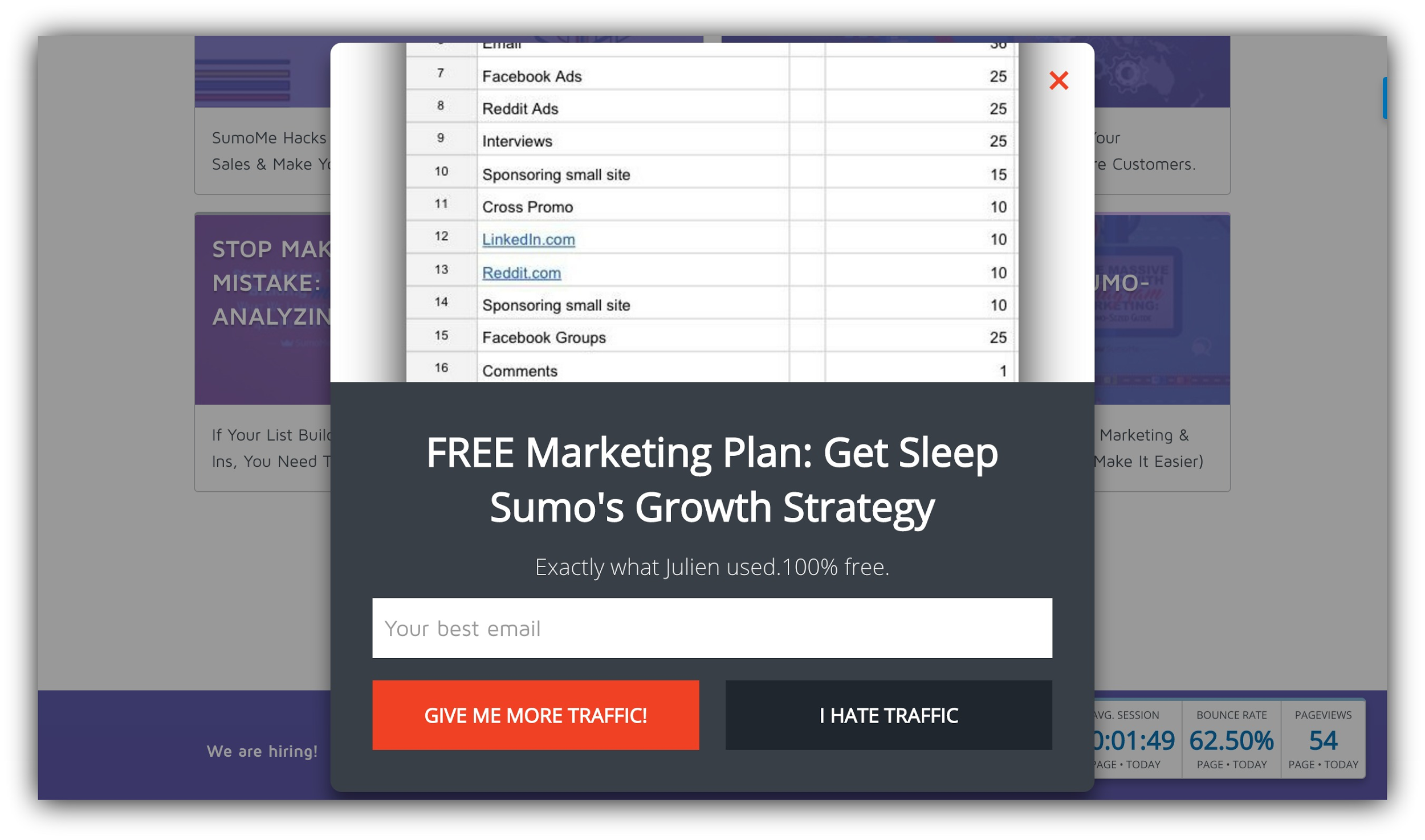
This isolates your call to action so your users have nothing to do but choose whether or not they’re going to follow through with it.
Don’t know what to remove? Check out the instructions in 5 Free Ways to Make Your Website More Effective NOW.
Strategy #15: Give Them More Opportunity to Opt-In
Let’s say you were to add a Welcome Mat to your website to collect emails.
And let’s say you did a great job with that Welcome Mat, and it raked in a 10% conversion rate. After all, you took the advice in this guide and optimized the shit out of the mat.
A 10% conversion rate is great, right? So do you just stop there? Leave the Welcome Mat up and call it a day?
Nope.
You increase your overall site conversion rate by giving your visitors more than one opportunity to opt-in.
Say you were to add to the Welcome Mat an exit intent pop-up. For the 90% of visitors who aren’t ready to give up their email addresses when they initially land on your page, you’re giving them another opportunity to subscribe when they go to leave.
Let’s say you were able to convert 5% of those visitors who haven’t already opted in with your Welcome Mat.
This boosts your overall site conversion rate to 15% – very healthy opt-in rate. If you get 200 visitors to your website each day, you’re collecting 10 additional emails.
Over the month, you’d net 300 more emails – and over the year, assuming you didn’t increase your traffic at all, that’s an additional 3,600 emails you wouldn’t have otherwise collected.
Neat, huh?
Don’t know where to put the opt-ins on your site? Here are 20 different places for your forms, ranked by effectiveness.
Strategy #16: Decrease Your Page Load Time
Your visitors have the attention span of a goldfish, maybe, but they have the patience of a gnat.
If your site doesn't load within 3 seconds of the visitor landing on the page, they’re most likely leaving…
And even a one second delay in your page loading can decrease your conversions by 7% or more.
Needless to say, if your visitors leave before your page loads, they won’t see your offer and therefore won’t subscribe. So you’ve gotta decrease that page load time.
A lot of the page load time is up to your servers. But there’s one thing you can do to make your site instantly faster: deactivate and delete plugins that make your site lag.
You can find out exactly which plugins these are by installing the super handy P3 Performance Profiler plugin if you use WordPress. The plugin will scan your site and show you your load time, and the impact your plugins have on that time:
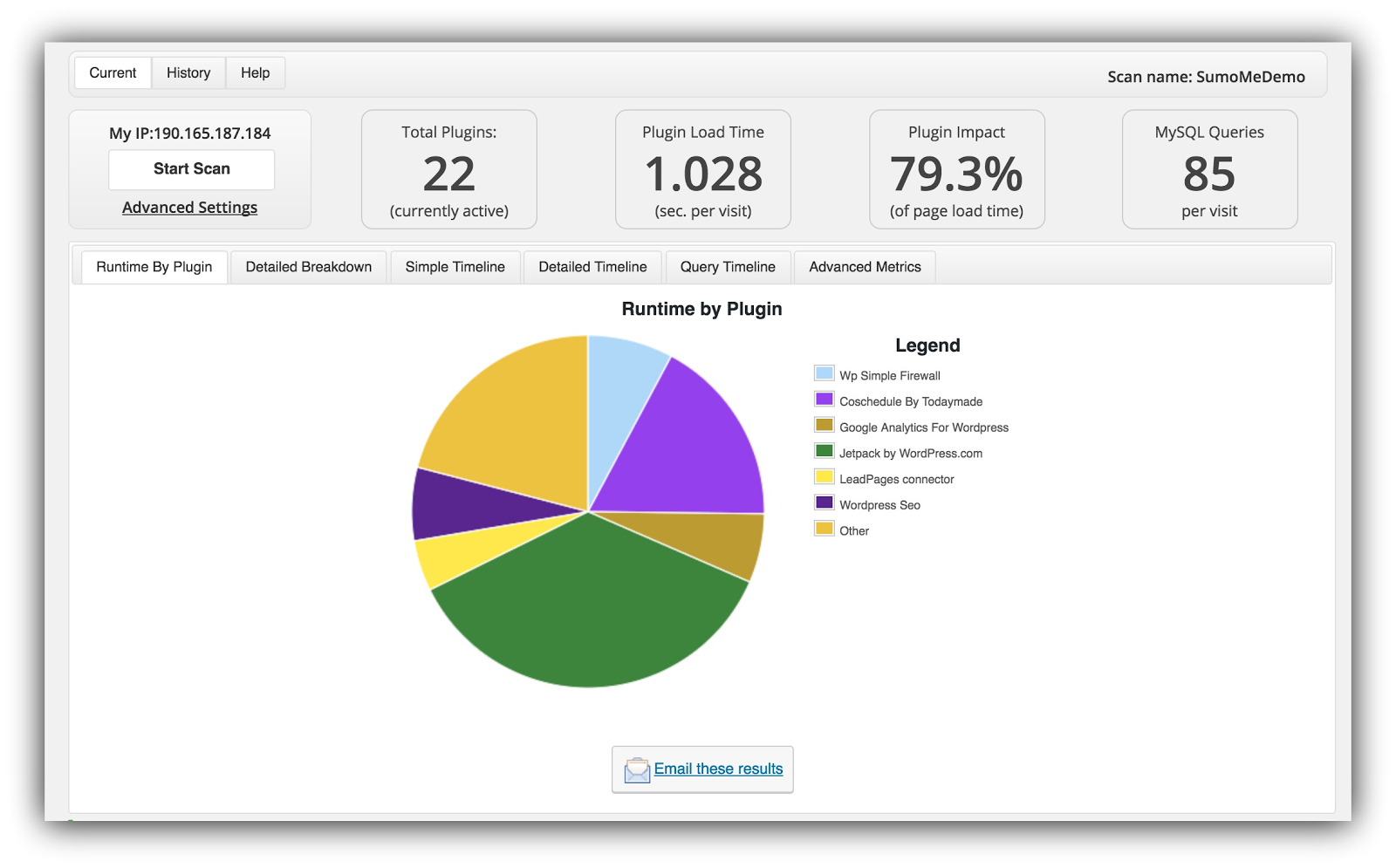
You can then deactivate the time sucks and increase your conversions in the process.
Have a slow plugin and don’t know what to replace it with? Check out our guide to the 57 best WordPress plugins of 2016.
Strategy #17: Make Sure Your Website is Responsive
You know that search engines hate non-responsive websites.
But search engines aren’t your only problem when it comes to conversions and traffic. As of 2015, mobile browser count outpaced desktop browsers. And you know who else hates non-responsive websites?
Humans. Humans hate them. And those browsers are made up of – you guessed it – humans.
At least I hope so.
And those humans are taking action from their mobile devices more than ever before. IN the past year:
- Smartphone conversions globally increased from 1.2% in 2014 to 1.53% in 2015, and
- Tablet conversions globally increased from 3.41% in 2014 to 3.75% in 2015.
-
But you won’t be able to take advantage of any of these conversions if you don’t have a site that’s mobile friendly.
This is as simple as ensuring your theme, calls to action, and content is responsive. Of course, all Sumo apps are responsive – and practically made for mobile – so you don’t have to worry about that.
But if you need help picking a mobile theme, here are 10 things we learned analyzing the best blog templates around.
Strategy #18: Make Your CTA Jump off the Page
You probably think you’re doing everything right.
You’ve created the perfect content upgrade. You know your readers want it, you’ve used their language to describe it, and you’ve even nailed down the perfect headline, full of power words and descriptive language.
So you go and weave calls to action into your content to get people to take action to get that content upgrade.
You probably even use a Click Trigger to make a two step opt-in, making your CTA even more powerful.
But don’t expect it to convert.
That’s not me just being harsh. In fact, at Sumo we often embed a two step opt-in right in our articles.
And this tends to work for us to the tune of thousands of email subscribers a week. But the problem is this: most people who do this just blend the call to action into the article.
Meaning that instead of jumping off the page, these opportunities are missed by most people. Because most people are slackers and don’t actually read your copy. They scan.
Rather than reading every word you’ve written, their eyes jump around until they see an image, subhead, or piece of text that jumps out at them. So it’s not enough to just link up your call to action and call it a day.
Instead of blending it into a wall of text, like I’ve done (woops!):
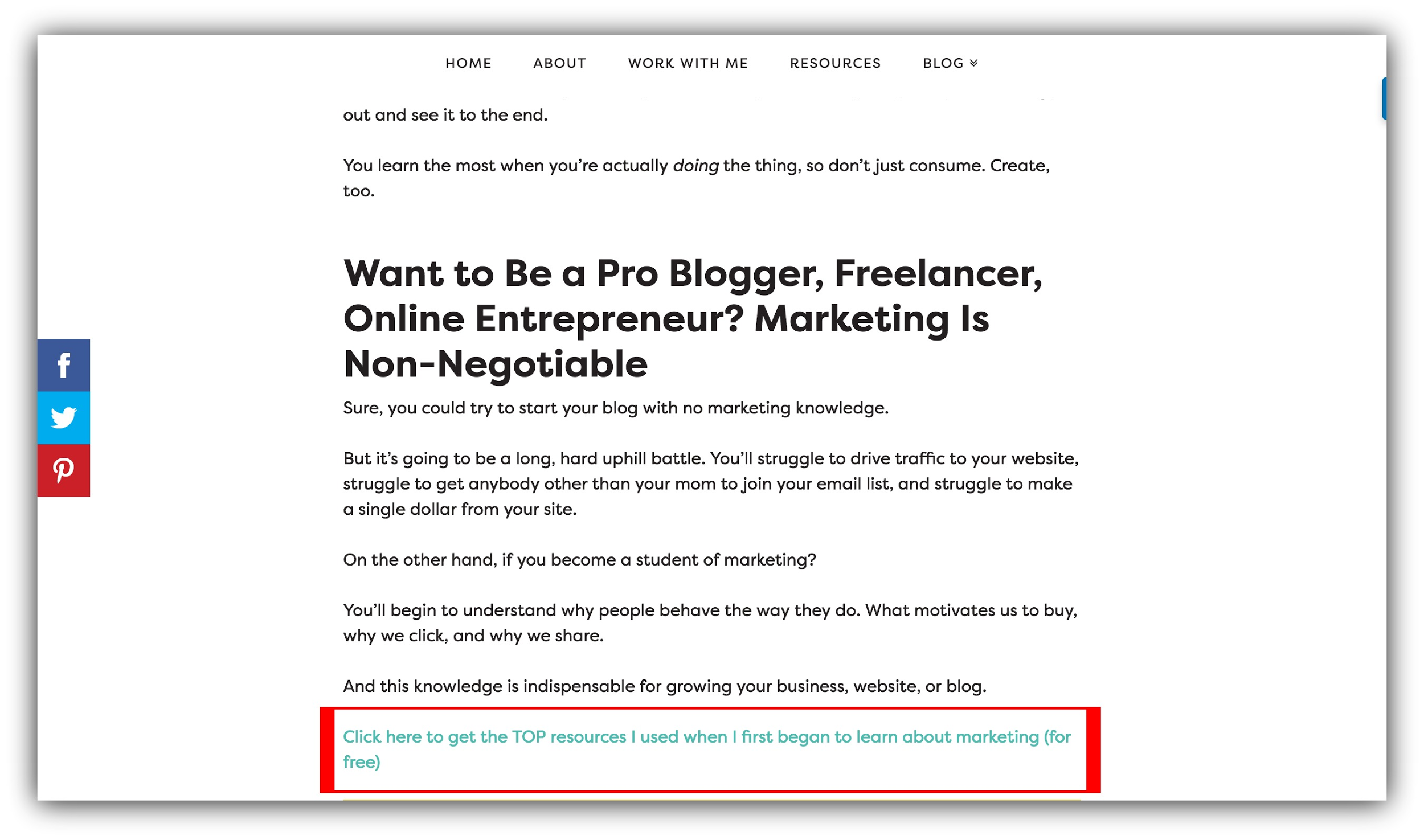
Give it a chance by making it stand out:
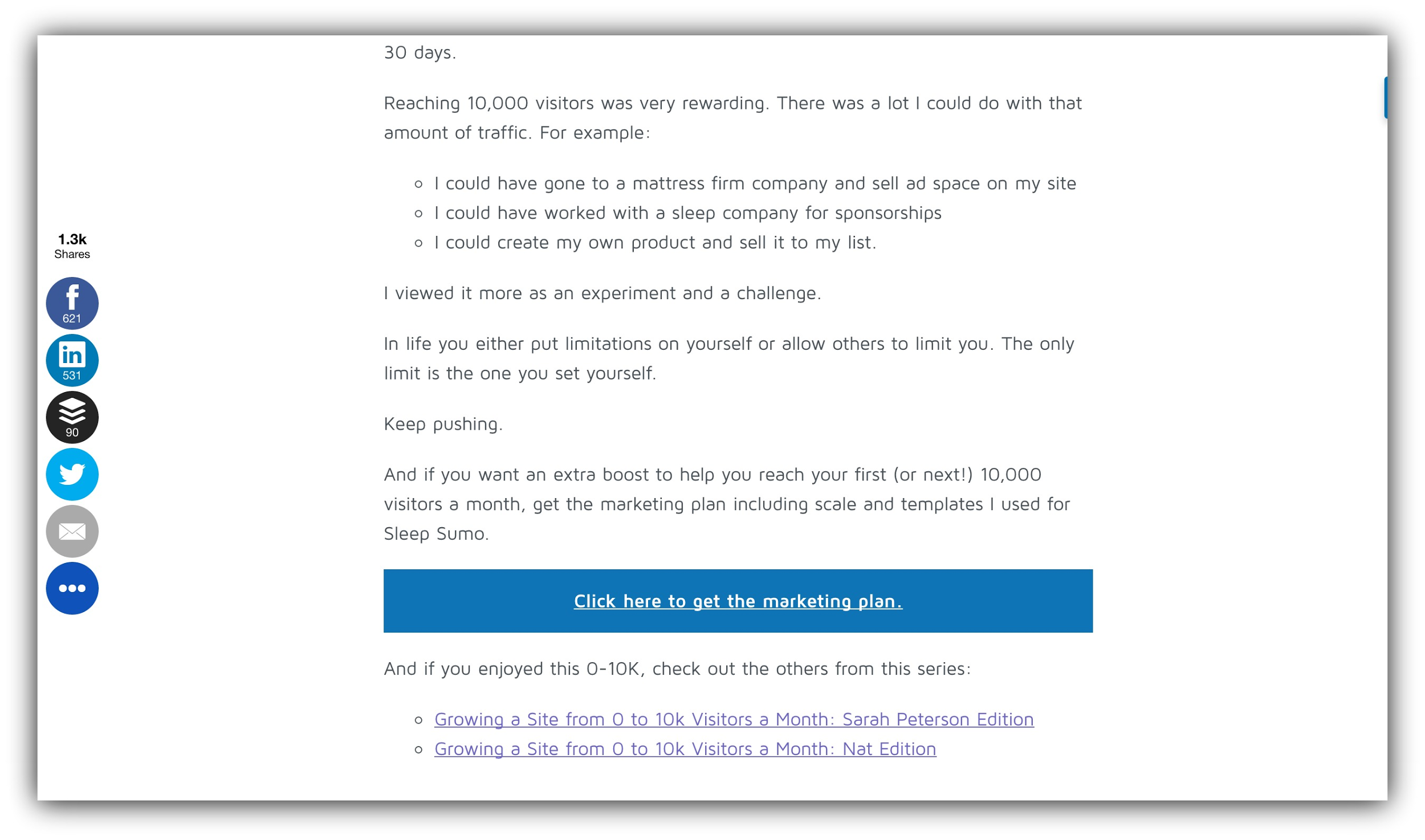
Use a form or a Click Trigger with a background or text color that jumps off the page. Append the CTA to an image, or break the scanning habit with an arrow.
The Click Trigger in the first example has a 50% conversion rate. Not bad…but it pales in comparison to the 77% conversion rate of the second example.
Don’t expect your readers to read every word on the page. They won’t. Make your CTAs pop.
Strategy #19: Pre-Empt Objections
You know those people who, upon receiving a helpful suggestion (or even a resource that could potentially change their lives) only give you a thousand reasons why it won’t work for them?
Yeah, those people are more common than you might think especially in the face of being asked for their email addresses… again.
So instead of just describing your offer and hoping it resonates with these types of people, help them become a little less wary by pre-empting their objections.
What are the holes they might poke in your offer? Fill those holes with a healthy dose of reassurance (provided that it’s genuine).
Take a look at how Smart Blogger pre-empts the objection to creating blog graphics of "but I’m not a designer!" in their headline:
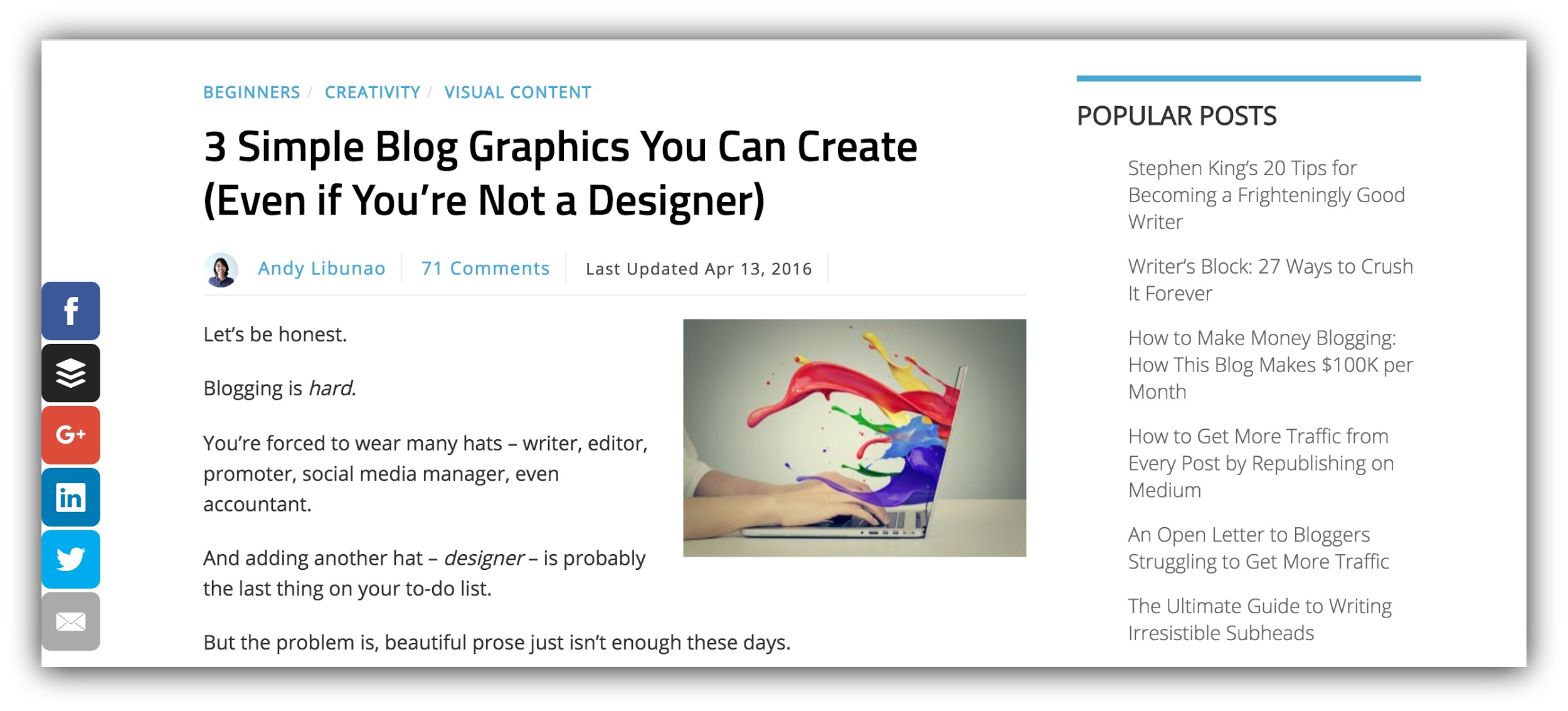
And how we reassured our readers that they didn’t have to know anything about growth hacking to use the strategies we were providing:

This can be used in your opt-ins as well.
Pre-empt objections in the headline or description of your offer to increase conversions (and give those types of people less to say "but" about).
Strategy #20: Use Social Proof
Research shows that 92% of people trust recommendations and endorsements from peers.
That’s not as surprising as the fact that 70% of people will trust a recommendation from someone they don’t even know.
Which means you can use recommendations and endorsements — in this case, in the form of social proof — to increase conversions.
Social proof is like baking those recommendations and endorsements right into your opt-ins.
Take a look at Tim Ferriss’ opt-in on his blog, The 4-Hour Workweek:
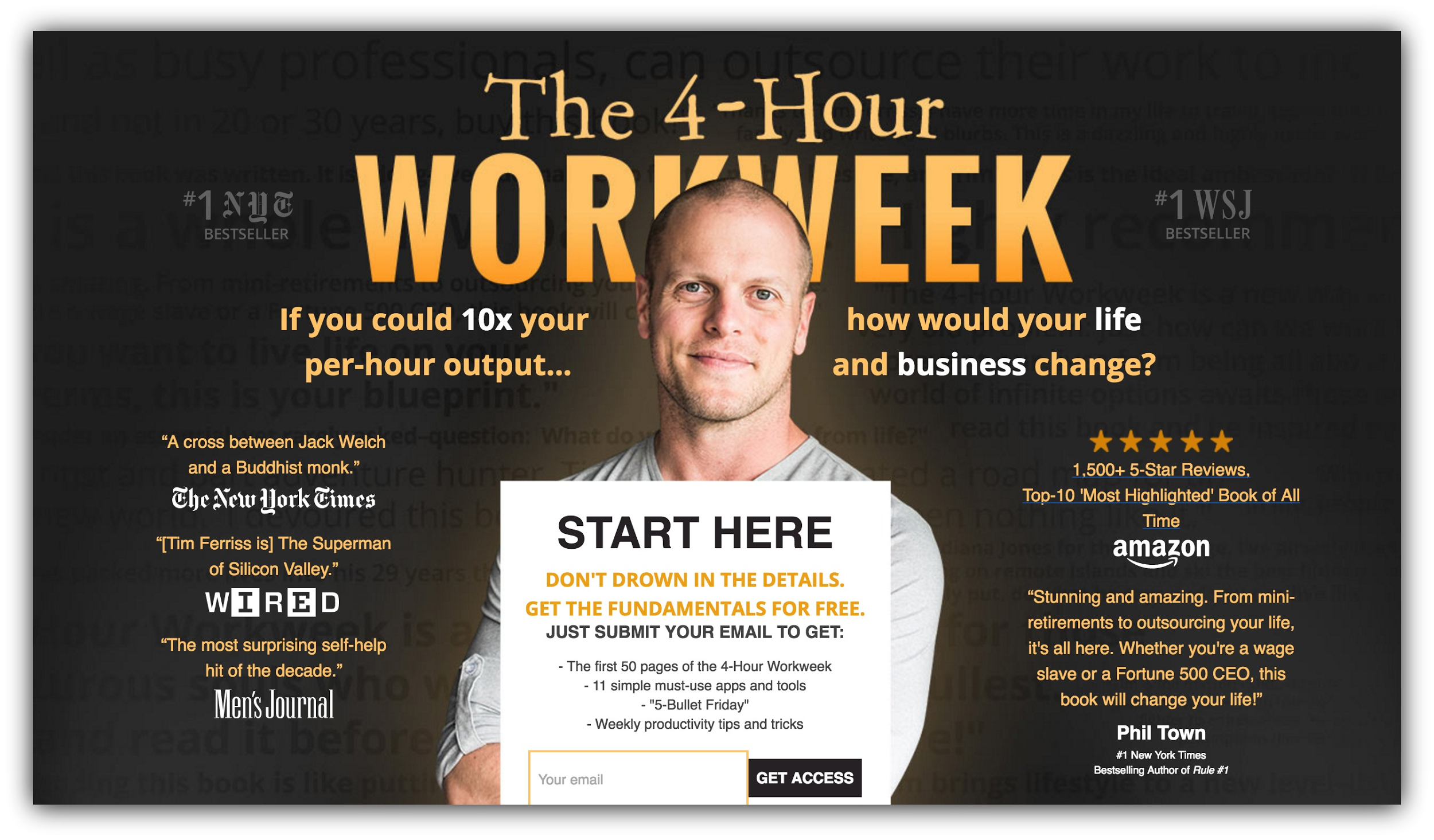
From quotes by Wired and Men’s Journal, 5-star reviews on Amazon, and badges for the #1 book on the New York Times and Wall Street Journal, Ferriss’ landing page is riddled with social proof.
Turns out this is for a reason: Tim is a legendary online marketer with a ton of notoriety – not to mention email subscribers.
Dude knows what he’s doing. Take a page from his book and use social proof to increase your conversions, too.
Don’t have any social proof yet? That’s ok. Here are 12 ways to build social proof (even if you’re starting from scratch).
Strategy #21: Use Testimonials and Quotes
As a form of social proof, testimonials stand on their own. So they deserve their own section.
They’re so effective, in fact, that just with adding testimonials, WikiJob increased their conversions in one A/B test by 34%
Even though we’re focusing on conversion rate optimization for converting traffic into email subscribers, testimonials still work insanely well. Think about it like this: if something works to get people to open their wallets and fork over money, it will almost definitely work to fork over their email address.
Whether you’re offering a freebie or just want to quote somebody who thinks you’re awesome, testimonials increase conversions. Check out how Cody MicKibbon from Thrilling Heroics uses testimonials for his opt-ins:
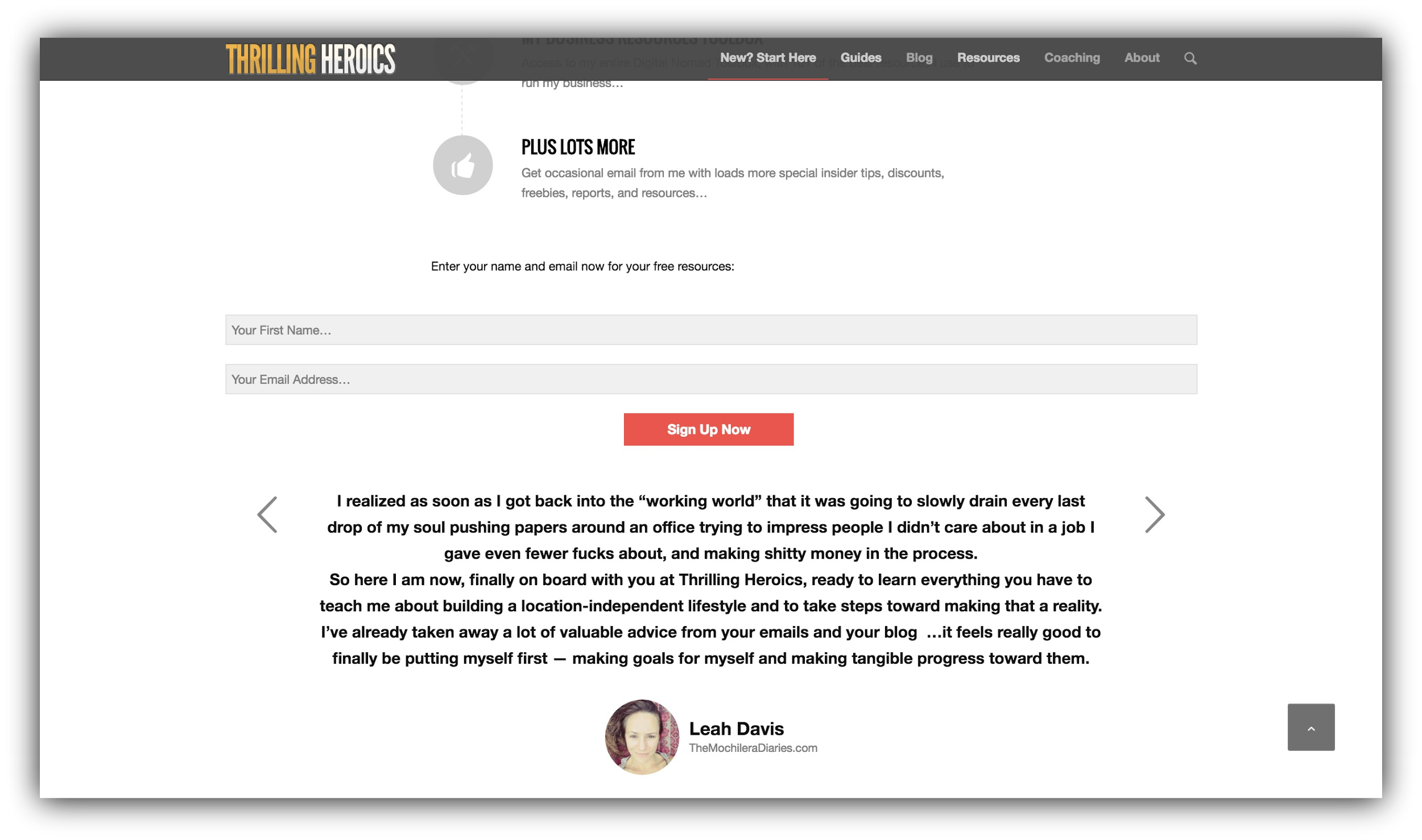
Testimonials prove that what you’re teaching has worked for others, which many use as an anchor to determine whether it will work for them.
Don’t know how to use testimonials in your opt-ins? Click here for your guide to the 9 types of testimonials with examples.
Strategy #22: Use Exclusivity
Remember when you were in high school and desperately wanted to be part of the popular crowd?
Me neither, but apparently some people did, and there’s a reason for the desire to be "in" with the “in crowd”: exclusivity.
See, when we perceive something as exclusive, it instantly becomes far more attractive to us. It’s this innate human desire to want what we can’t have that makes using exclusivity as a conversion optimization strategy so effective.
You don’t have to be rich and famous or leave anybody out a la Mean Girls to benefit from exclusivity.
- Do you have a certain amount of spots you can offer before you close your opt-in?
- Can you make it feel like an exclusive club that only super committed people can join?
- Do you offer content and tips in your emails that only your subscribers will see?
-
Check out how Brian Dean from Backlinko uses exclusivity just with the word "exclusive":
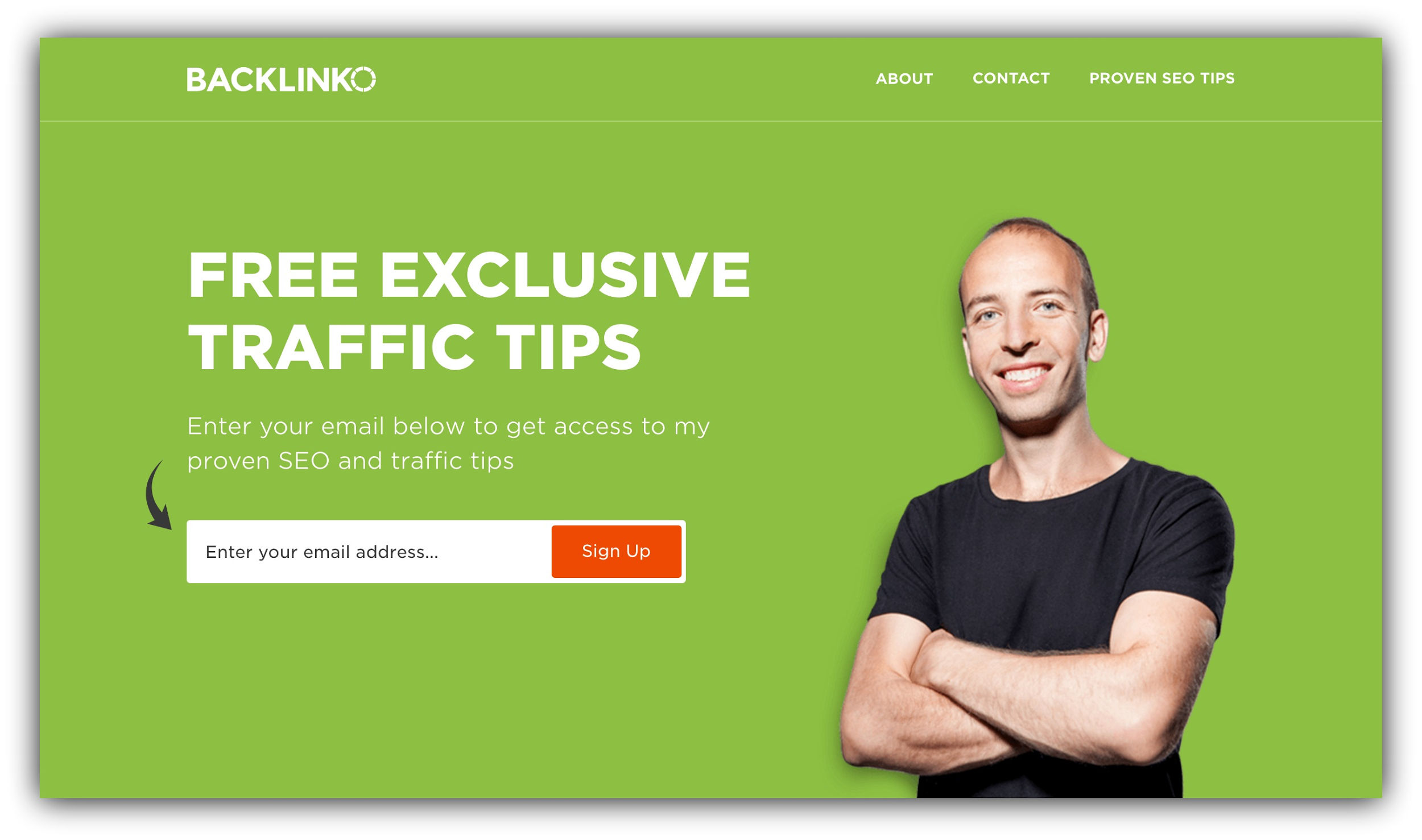
He’s using the idea that he doesn’t offer the tips publically on his blog to trigger that feeling of exclusivity.
If you can work it in, try exclusivity out for size.
Strategy #23: Get Your Foot in the Door
If I asked you to donate $0.25 now and you said yes, did you know you would be far more likely to donate $10 later on?
You may not have known this, but a ton of smart companies do, and even charities. They employ the "foot in the door" technique, in which studies have shown that if you get somebody to say “yes” to a smaller request, they’re more likely to also follow a larger request later on.
This can be used for good or evil, but not to worry – growing your email list by providing value to your audience isn’t evil. It’s downright smart.
And this technique actually works so well that there’s a special type of opt-in made specifically to employe this technique:
The two step opt-in.
A two step opt-in is when you click on a link, image, or button to trigger a pop-up, like this List Builder Click Trigger in action:
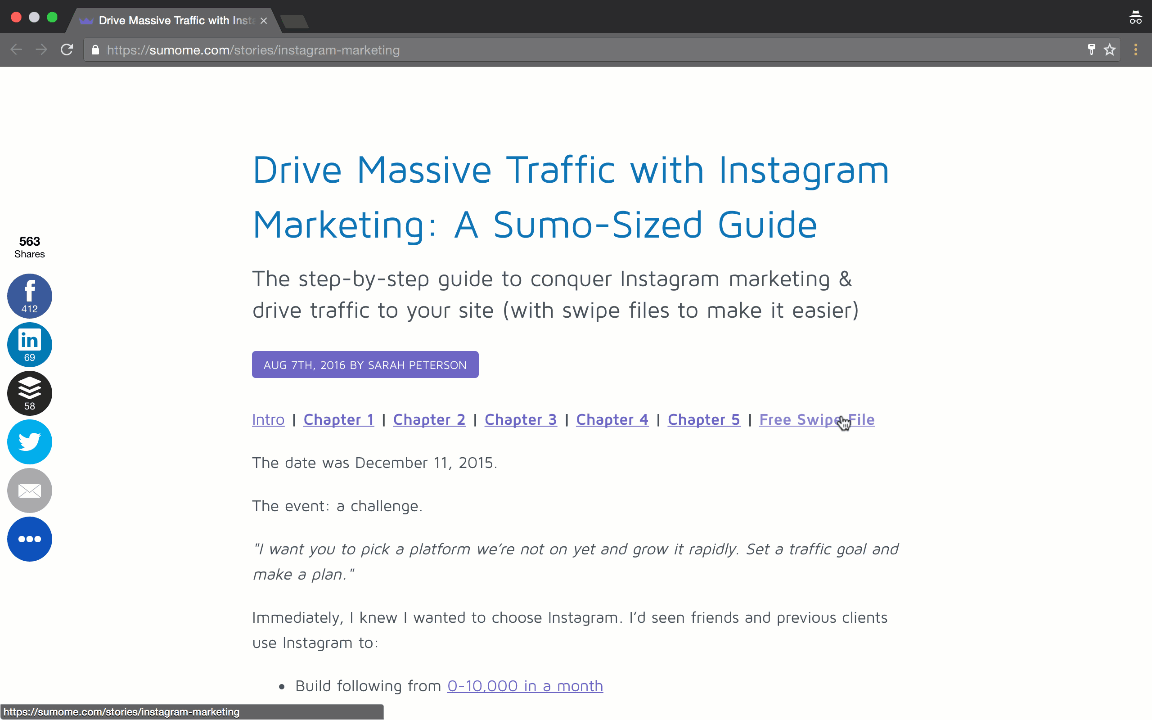
This works so well for two reasons:
- The user is actually asking for the pop-up. Pop-ups work well either way, but when you’re triggering it yourself, there’s usually a reason: because you want the offer.
- You’ve gotten your foot in the proverbial door. The smaller request is the link, button or image, and the larger request is filling out the pop-up and opting in.
-
Two step opt-ins work so well that they can boost your conversions from a site-wide pop-up:

To 10x:

Two step opt-ins are a powerful tool in conversion rate optimization. Can you set up a Click Trigger to offer a content upgrade, your opt-in offer or even your general website subscription?
You can use them in feature boxes, your menu, or any other clickable element on your website.
Don’t know how to create a Click Trigger for your menu? Click here to find out how to give your audience more opportunities to subscribe with a two step opt-In.
Strategy #24: Trigger Fear with Scarcity
It’s one of the oldest marketing strategies in the book.
It’s been used by some of the greatest advertisers and marketers in history. And it’s so popular because it works like crazy.
The strategy?
Scarcity.
Scarcity is legendary for increasing conversions. Making something a limited time offer, putting your product on sale for just a couple of days, or sharing that you have limited stock can increase your conversions by hundreds of percentage points.
For example, this ecommerce store split tested an offer where they used scarcity (a limited time, next-day shipping offer) against a control version where the offer wasn’t displayed:
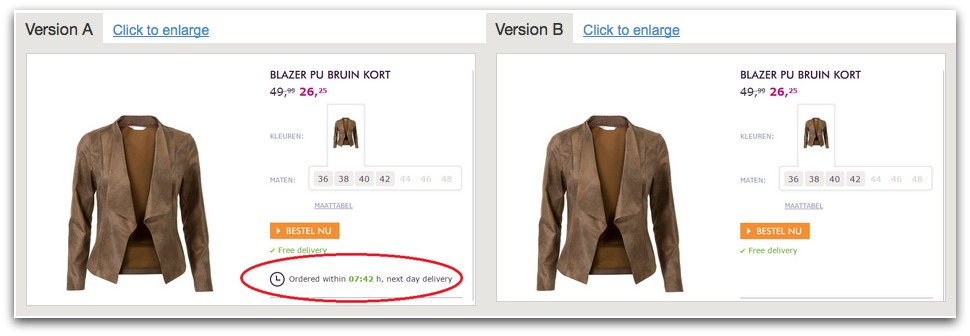
And just by using scarcity, the limited offer increased conversions by over 226%.
Impressive, right?
This doesn’t just work for ecommerce, though.
You can make it work for your opt-ins, too. Use a countdown timer on your pop-ups or opt-ins to offer your upgrades for a limited amount of time, making your audience act now – or never.
Not sold on scarcity? Check out these 9 essential ways to use scarcity to increase conversions.
Strategy #25: Build in Urgency
Have you ever felt like you have a problem that needs to be solved so badly that you can’t imagine going on like you are for any longer?
Maybe it’s a toothache, or a half renovated kitchen. Or maybe it’s a business that’s not making enough money.
You’re feeling the urgency of the situation in these cases. You’re anxious to get the problem solved. So what would you do if you came across an opt-in that not only could help you solve your problem, but reminded you of the urgency of the problem?
You’d probably opt in.
Scarcity and urgency sound like similar concept, but they’re not.
Where with scarcity, you’re taking the offer off the table if they don’t act, with urgency you’re aggravating their problem and making them feel as if it’s more urgent than ever that they fix it.
And to be honest, it probably is. So include urgency in your offers to increase conversions.
- If they don’t act on your offer, how will your visitors’ quality of life suffer?
- What pains are they feeling that your offer could solve?
-
Sometimes, you can’t build in urgency. If you sell kids toys, chances are you can’t aggravate any problem such that it’s crucial that your customers act now lest they perish (or their quality of life drastically declines).
But if you teach parents how to sleep train their rowdy 8 month olds, you can build in urgency quite easily by reminding them how sleep deprived they are, and foreshadow what it will be like if their precious baby doesn’t sleep on his own until he’s 9.
Aggravate the urgency of the situation your visitors tend to be in, and watch the conversions roll in.
Strategy #26: Use Human Faces
I know something about you with certainty even though I’ve never even met you.
Heck, I may not even know your name.
But I know that you’re attracted to human faces. And I know you might be thinking "well, it depends on the face," but that’s not accurate.
You track out a human face faster than the blink of an eye (pun intended), and this is proven by study after study.
Take a look at this heat map with eye tracking software Dolce and Gabbana ad that Business Insider reported on:
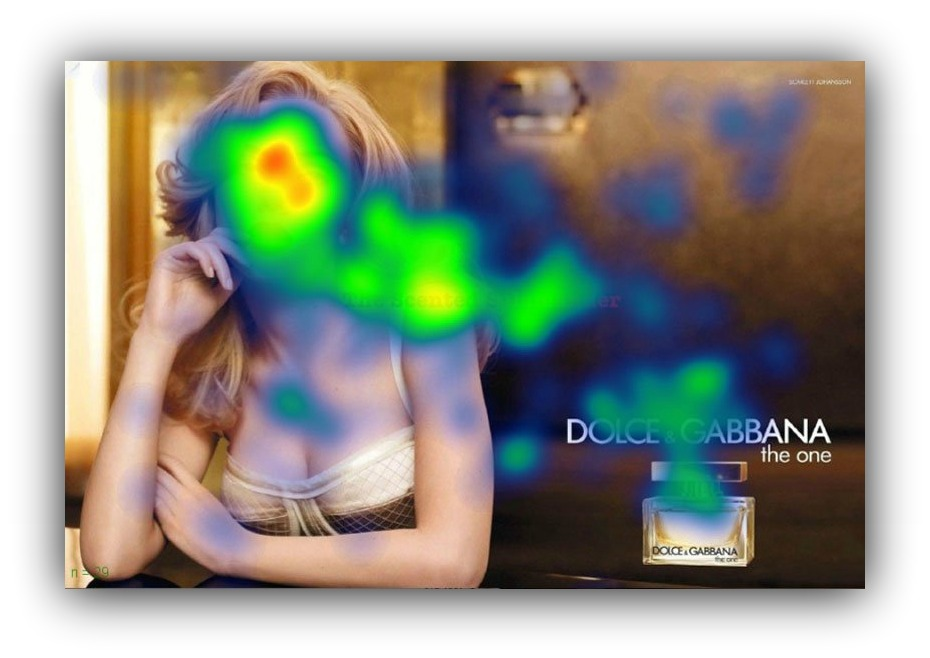
Okay, so you might be thinking that of course the eyes are drawn to Scarlett Johansson's perfect face.
But it’s not just her face. Take a look at how the software lights up when the faces are on the screen:
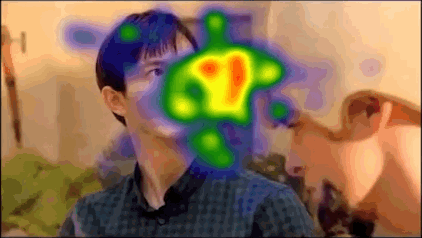
Human faces work so well that Signal v. Noise reports an A/B test that shows that using an image of a person in the design of a sales page increases conversions by 102%.
No need to belabor this point: human faces convert.
Include your photo or a customer’s photo on your Welcome Mats, pop-ups, and feature boxes.
Just please don’t use cheesy stock photographs!
Strategy #27: Use Lines of Sight
You might assume that we’re more evolved as a species than this, but you’d assume wrong:
We tend to look for directional cues as to where we put our eyes.
What do I mean? Well, for example, if there’s an arrow pointing at something, we can’t help but look at it.
We also can’t help but follow any line of sight that’s created for us, whether that be a set of eyes looking at a product in an advertisement or an arm subtly swooping toward a headline in a blog graphic.
You can use these lines of sight to draw attention to your call to action button or headline, to lead your visitors to the water.
Check out how Steve Kamb uses lines of sight with his elbow and eyes to not only guide your eyes to the headline and subhead, but also the CTA button:
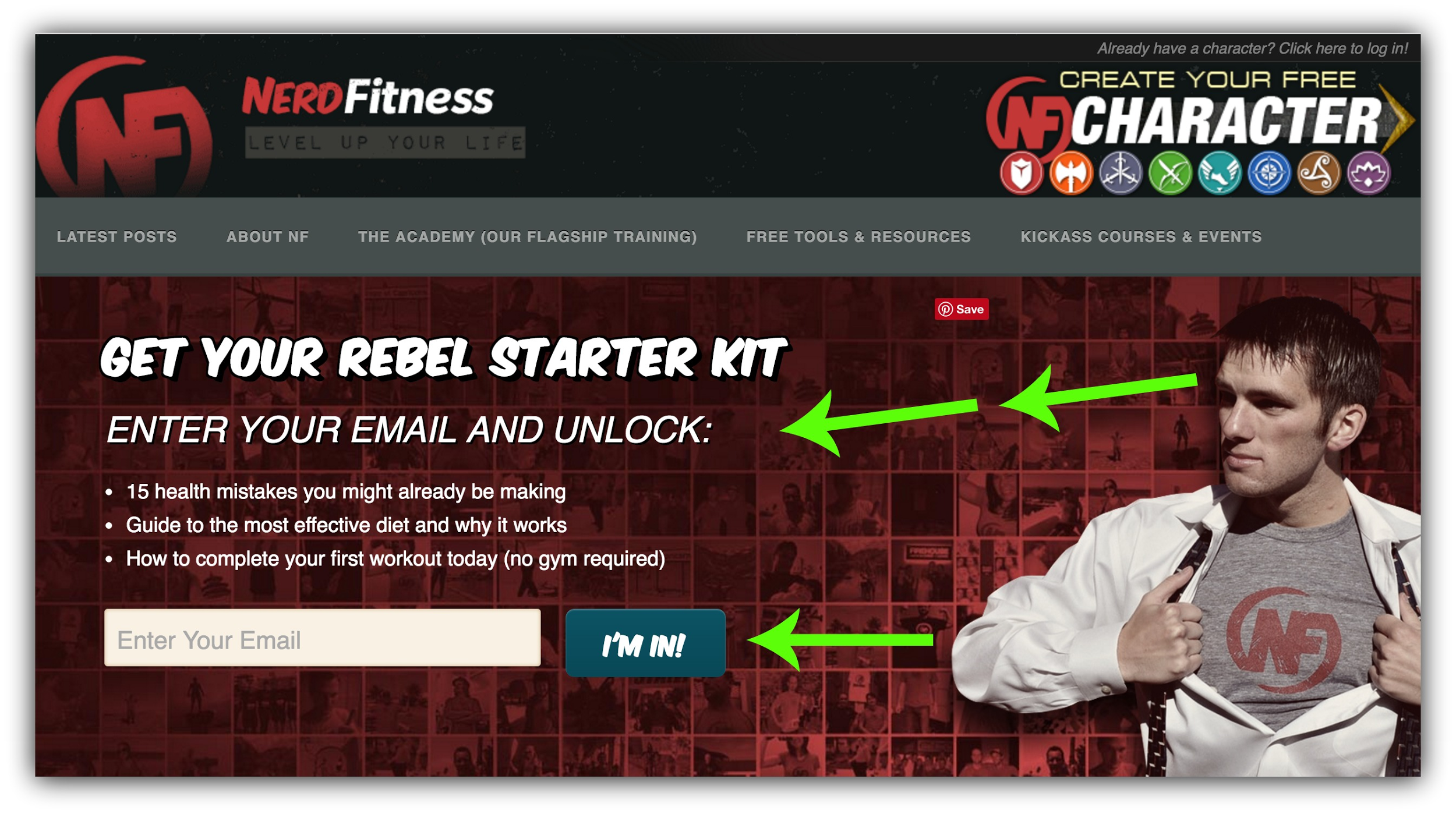
Lines of sight are used by advertisers to capture attention and control where your eyes go. Why not use them to increase conversions?
Oh, hey, and if you feel like one-upping yourself? Use a human face with a line of sight, like Steve’s done above by leading the eyes of the person in the photo to the product or call to action. Check out how SunSilk did this in an ad Business Insider featured:
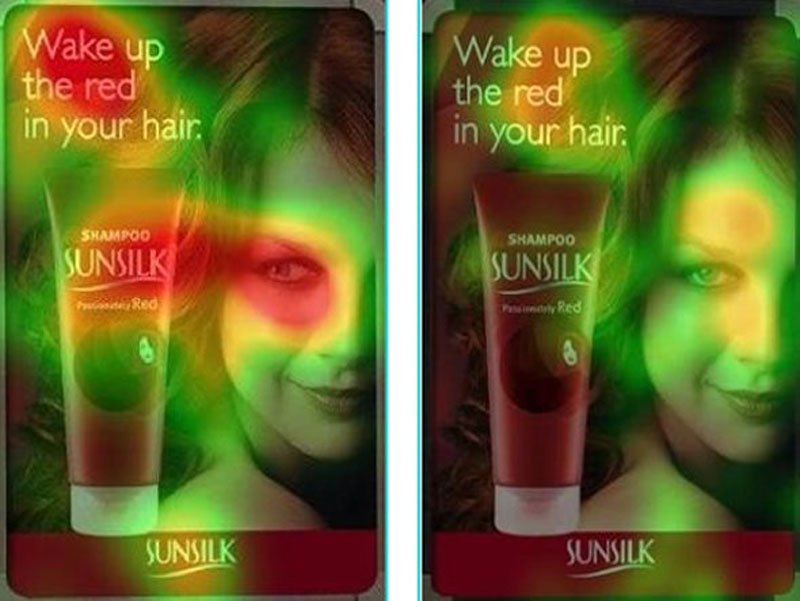
Or this Pepsi ad with the human and the straw serving as the line of sight:
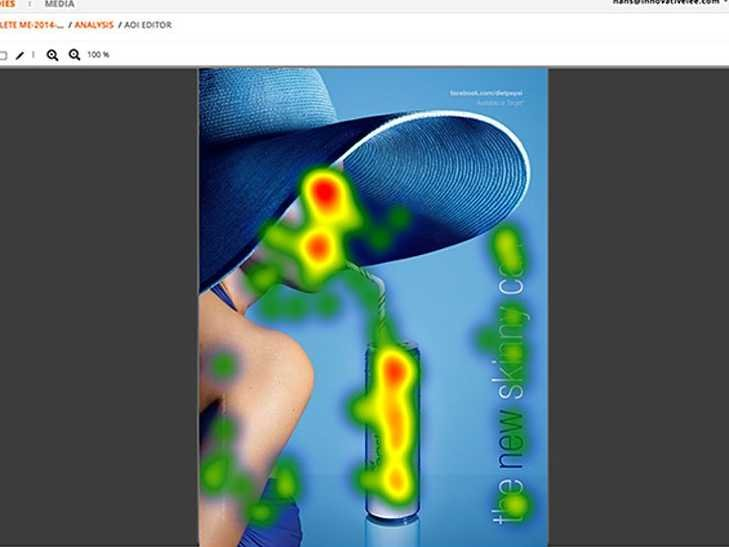
See? Timeless, and a strategy the pros use.
Strategy #28: Use Motion
Many of these conversion rate optimization strategies so far have been centered around making your opt-ins more eye catching.
Because if nobody notices your opt-ins, you can bet nobody will actually opt in.
And what’s more eye-catching than the unexpected?
Typically, when we land on a web page we are met with static images and still elements. The exception is your slider, and we’ve proven that those are wildly ineffective.
So break that still-life pattern and put things in 3D – with movement.
Check out how we’ve used the Motion template in our Welcome Mat opt-in for a content upgrade:
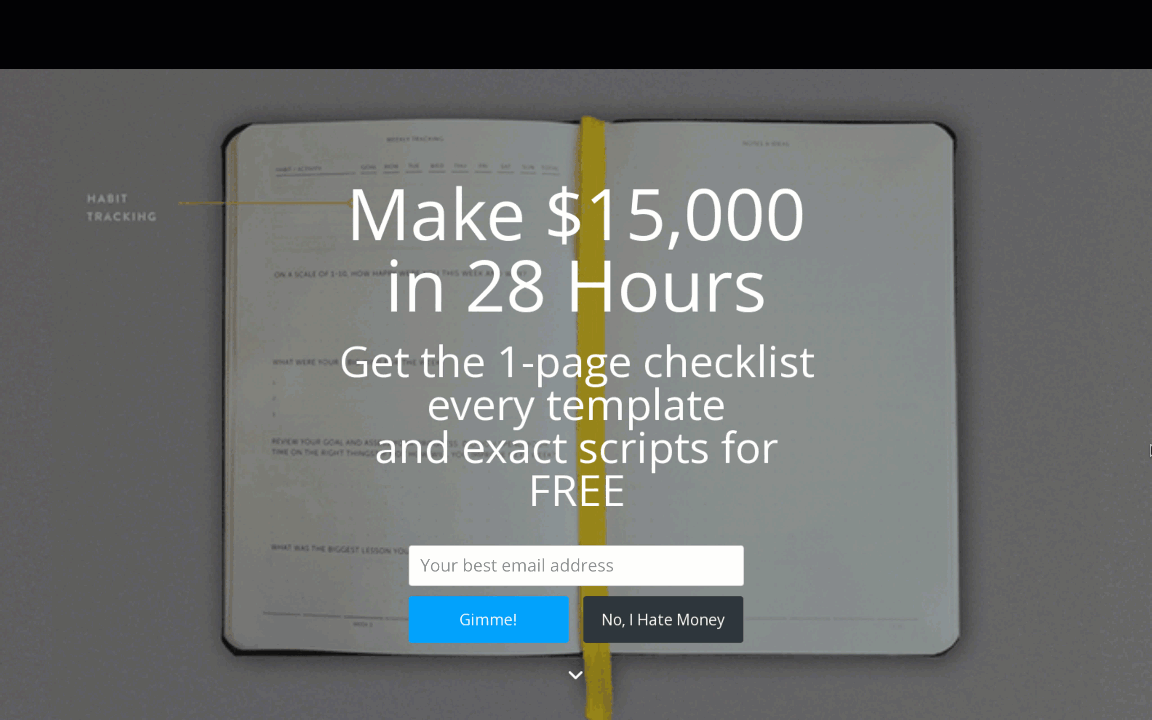
Converting at well over 20% and outpacing many of our still Mats.
Try to incorporate motion in your opt-ins to capture attention and add visual interest.
Strategy #29: Show ‘Em What You Got
Have you ever purchased something blind?
Meaning that you bought the thing online without even seeing a photo of it?
I mean, you could. For example, you don’t need to see a picture of a book to buy it. It should make no difference to you what a brand new book looks like in the stock photo.
You could probably also buy groceries online without looking at a picture of it. You already know what a tomato looks like – you don’t need the grocery store’s stock photography.
But you don’t. Because not knowing what we’re in for is uncomfortable for the average human.
The same goes with your offers. Instead of expecting your visitors to give you their email address in exchange for something completely blind, include an image of the offer. Maybe you take a screenshot of the spreadsheet you’re offering and use it as the background photo.
Or maybe you blur out a page of your eBook or freeze a frame of your free video course and use it as your opt-in image:

There’s a few reasons this works:
- It makes it more tangible. It’s as if text alone (or irrelevant images) makes the offer less real.
- It triggers curiosity. If you show some of the offer, but not all of it, your visitors will want to see the rest.
- It makes it more enticing — just like a commercial with glistening buffalo wings makes you crave wings, you can draw visitors in with a picture of your offer.
- It gives people context. Context is why we don’t like to buy things blind.
-
So include an image – preferably with lines of sight and motion – with your opt-ins.
Strategy #30: Make Them Make a Choice
The other day, I was researching how to learn French, and I saw an interesting headline on Facebook about it.
When I clicked onto the headline, I was on a mission, and immediately started to scroll down so I could get to the content.
But because of my knee-jerk reaction, I scrolled right out of a Welcome Mat that the site was offering. I barely glimpsed the headline of the freebie before I lost the Mat forever, but I did catch a few words that piqued my interest.
Luckily, I spend all day every day on the internet, so I knew I could just re-visit the site from an incognito window to trigger the Mat again.
But most people don’t spend nearly as much time online as I do and don’t know little tricks like that, so you could be losing tons of opt-ins to eager Eddys like me, chomping at the bit to get to the content.
To combat this reaction and increase conversions in the meantime, make it so it’s not super simple to scroll or quit out of your opt-ins.
Make your visitors make an intentional choice, rather than lose them by default.
You can do this by eliminate the ability to scroll out of the Welcome Mat or put them on a squeeze page to make them make a choice – either they’ll opt in, or they’ll choose not to.

In Welcome Mat, toggling Instant Landing Page on will remove the scroll out option so your visitor has to click a button to decline your offer.
This can increase conversions based on our tests by 2x or more.
Strategy #31: Show How Far They’ve Gotten
Have you ever began to eat a meal, and even though it didn’t taste all that good, finished it?
Or how about started coloring a page in your kids’ coloring book, and even though you screwed it up with terrible color pairings, you finished up the page?
You probably did those things because we humans have an innate obsession with finishing things that we’ve already started.
I know, I know. You may be casting glances at the unfinished paint job in your bathroom that your husband keeps promising he’ll complete, but it’s true. We like the satisfaction of having completed something.
Hence why my mom always used to get mad at me for opening another carton of milk when there was already an open one in the fridge.
So trigger that reaction in your visitors with a progress bar. Show them how far they’ve gotten in the process of signing up for your list:

If they see they’re 50% complete, they’ll want to see that jump to 100%.
Why do you think you’ve stuck with finishing a long customer satisfaction survey that regretted starting before?
Strategy #32: Consider Ditching the Opt-In Disclaimer
This might surprise you, but by telling people you won’t spam them, you might be chasing them away.
Yup, you read that right.
When somebody is browsing your website and up pops a pop-up or a Welcome Mat, chances are they’re probably not thinking about you selling their email address.
If you did a good job with your landing page or opt-in, chances are they’re reading your headline, your description, and making a decision.
So to then interrupt their trajectory by saying "oh by the way, we won’t spam you", all they see is the word “spam”:
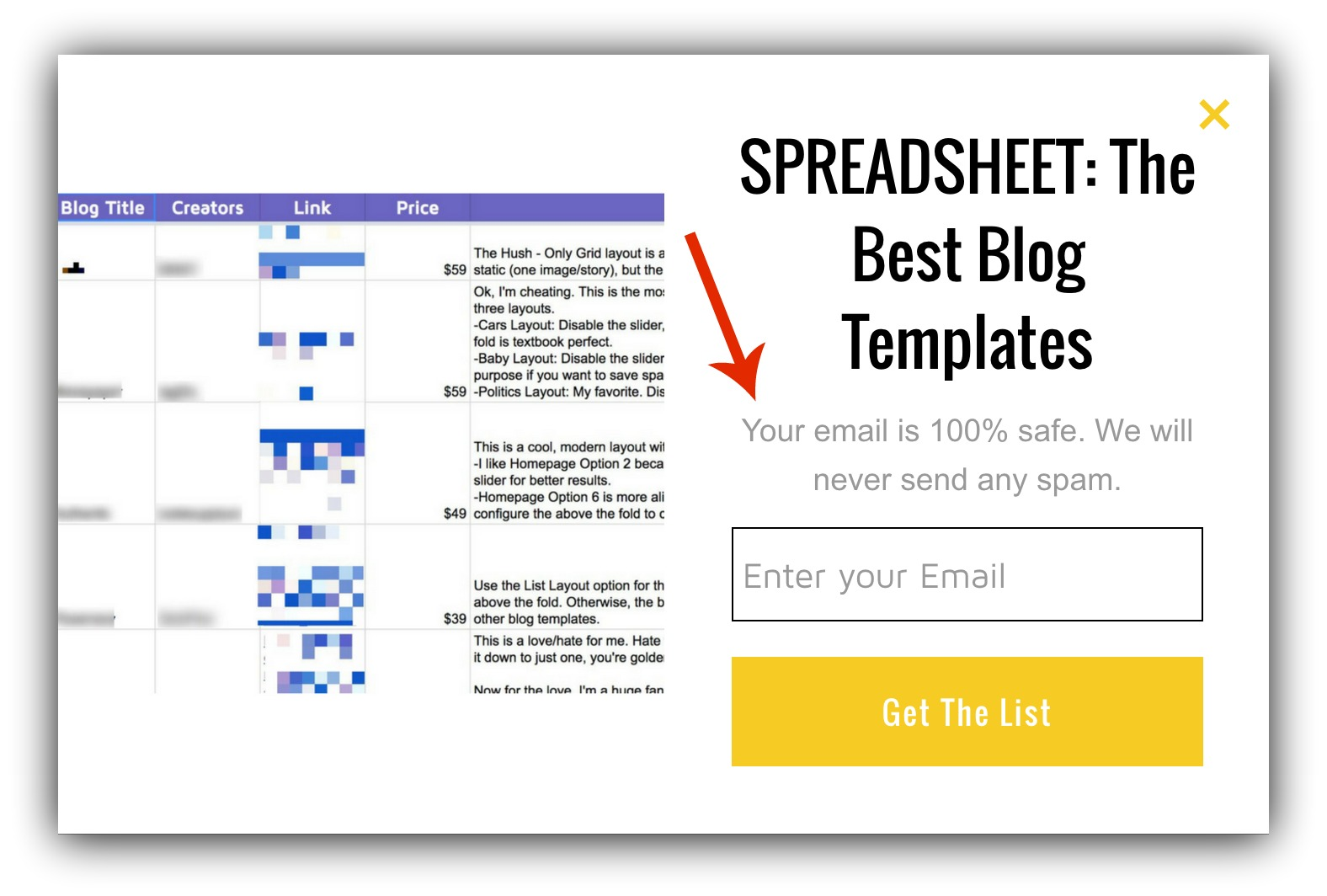
It’s like reminding them that there ever was a possibility that you might, even if they weren’t thinking about it to begin with – and chances are, they weren’t.
So rather than make them feel safe, it puts them on edge. On edge enough to not opt-in.
It’s like telling a four year old after reading her a book at bedtime: "oh by the way – there are no monsters under your bed".
Instead of making her feel secure that there are no monsters under her bed, all she hears is "monsters under your bed". It alerts her to the possibility that yes, there could be monsters under her bed, why didn’t she think of that earlier?!
So ditch the opt-in disclaimer.
This isn’t an exact science – if you have an older target audience, the opt-in disclaimer may quell their fears – but try it out and see how it affects your conversions.
Strategy #33: Stop Asking for Too Much Information
I can’t count how many times I’ve done it.
After a call with customer service or an online chat, I’m asked to take a "short" customer satisfaction survey. It would be helpful to the company and I’d get a chance to win something.
I’m a good person, so I agree (it has nothing to do with the chance to win!) and there I am, feeling good about myself and my helpful ways. But as I press "next" on question after question, I become frustrated.
What happened to "short" anyway? Why am I spending what seems like hours (but is probably only a matter of 10 minutes) answering question after question with no end in sight?
I almost always quit out of these types of surveys (unless there’s one of those progress bars…). The chance to win isn’t worth so much of my time and effort.
Your audience is no different. We humans are lazy creatures that want the biggest bang for the smallest amount of effort. So if you ask for too many pieces of information, they’re going to throw in the towel and not give you any – including their email address.
As far as the impact of asking for every single piece of information from your visitors to subscribe them?
Well, if you just cut your number of form fields from 4 to 3, your conversion rate could increase by 50%.
Imagine if you only asked for one field:
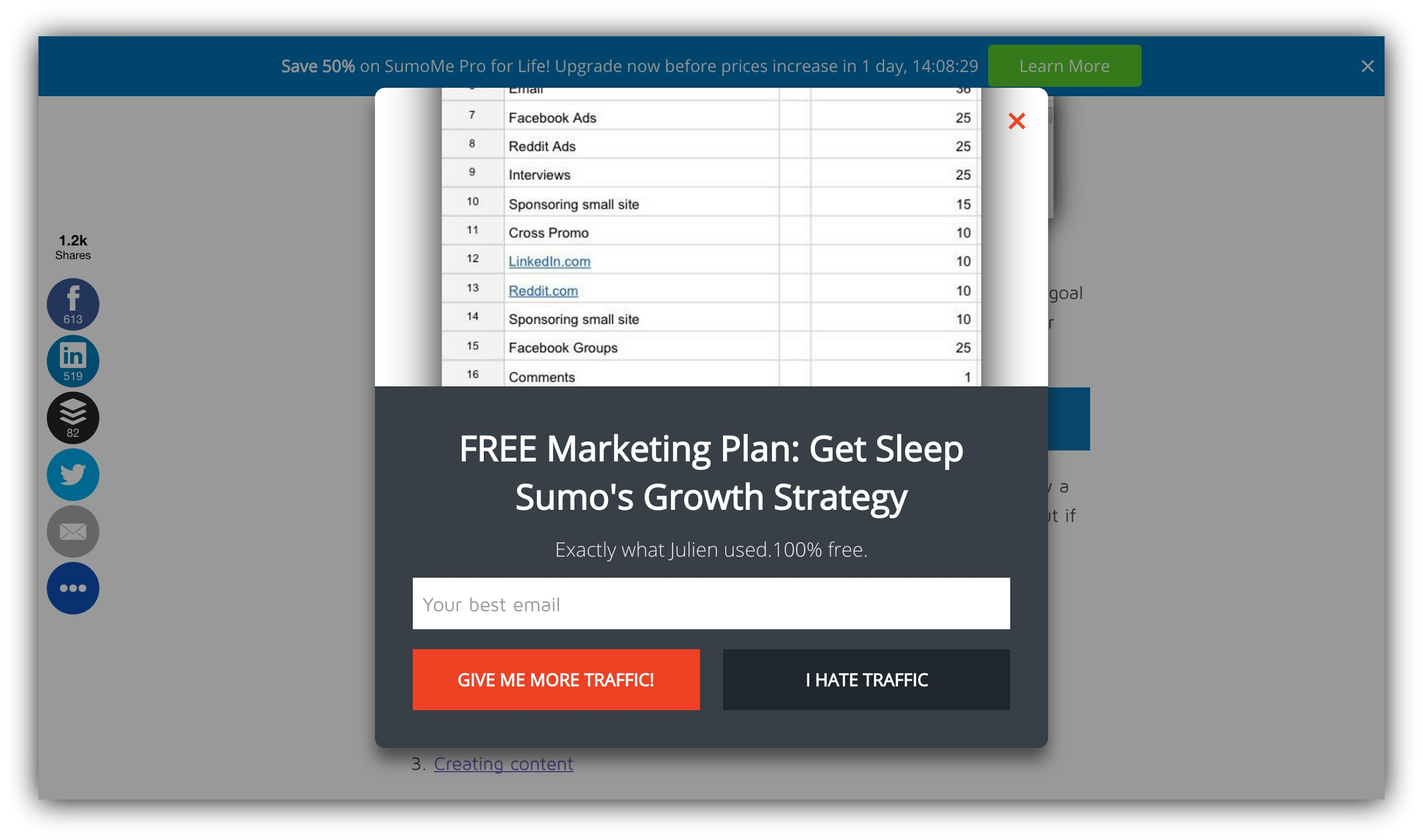
Don’t make people work for it.
Asking for too many form fields or making them fill out an excessive amount of info is not the way to convert.
Strategy #34: Don't Just Trust These Strategies Will Work For You
I’ve just listed 34 strategies to increase your conversions.
For many of them, I’ve provided examples, cited research, and shown you experiments that prove the strategy works.
But that doesn't mean they’ll all work for you.
These strategies work generally, and if you implement them all, they’ll almost definitely increase your conversion rate significantly.
But how effective will they be for your website? Well, that largely depends on your industry, your audience, and your brand.
Don’t take all of these strategies for granted. You’ll only know what pushes the needle for your audience if you actually test what your audience responds to.
A/B test button colors, button copy, and headlines. Try out different language (like the word "get" and “free”), freebies, and images.
Split test using a progress bar, removing your opt-in disclaimer, and throwing up a countdown timer.
Remember that many of these strategies make other strategies impossible. For example, you can’t both use motion with a blurred out image of your offer. Test to see which one will be more effective for increasing your conversion rate.
You can’t possibly know what works with your audience until you test.
We gave you a lot of meat in this guide, so as you go through these strategies, you need to stay on track. So we've put together a FREE spreadsheet with every single strategy for increasing your conversions
Add A Comment
VIEW THE COMMENTS